Social Media Intelligence: Analyzing Political Polarization in AU
VerifiedAdded on 2023/06/11
|25
|4405
|287
Project
AI Summary
This project explores political polarization within the Australian political landscape using social media intelligence techniques. It aims to determine whether political parties are disjoint and to examine the relationships among political leaders and their supporters on Twitter. The study involves collectin...
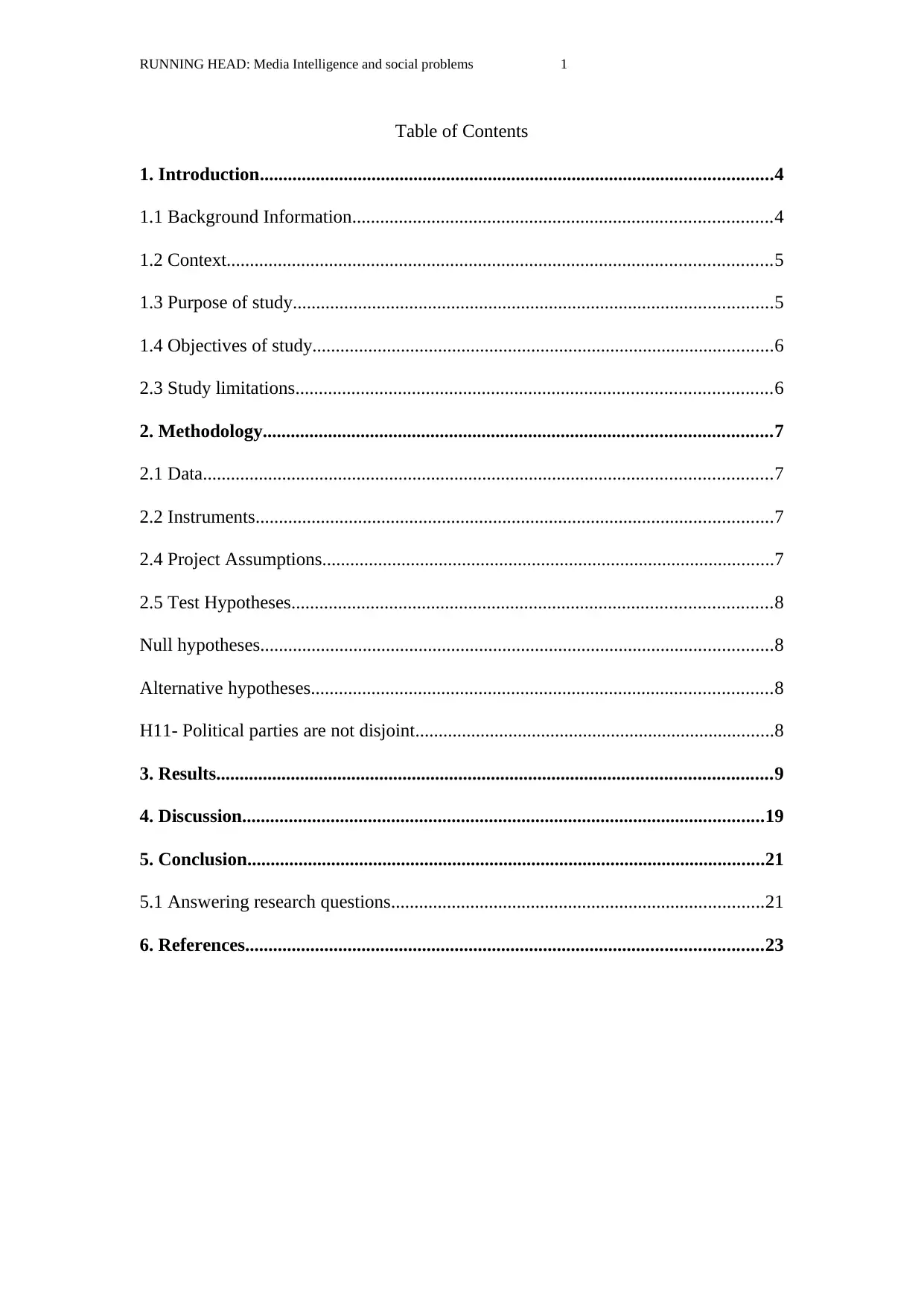
1RUNNING HEAD: Media Intelligence and social problems
Table of Contents
1. Introduction..............................................................................................................4
1.1 Background Information..........................................................................................4
1.2 Context.....................................................................................................................5
1.3 Purpose of study.......................................................................................................5
1.4 Objectives of study...................................................................................................6
2.3 Study limitations......................................................................................................6
2. Methodology.............................................................................................................7
2.1 Data..........................................................................................................................7
2.2 Instruments...............................................................................................................7
2.4 Project Assumptions.................................................................................................7
2.5 Test Hypotheses.......................................................................................................8
Null hypotheses..............................................................................................................8
Alternative hypotheses...................................................................................................8
H11- Political parties are not disjoint.............................................................................8
3. Results.......................................................................................................................9
4. Discussion................................................................................................................19
5. Conclusion...............................................................................................................21
5.1 Answering research questions................................................................................21
6. References...............................................................................................................23
Table of Contents
1. Introduction..............................................................................................................4
1.1 Background Information..........................................................................................4
1.2 Context.....................................................................................................................5
1.3 Purpose of study.......................................................................................................5
1.4 Objectives of study...................................................................................................6
2.3 Study limitations......................................................................................................6
2. Methodology.............................................................................................................7
2.1 Data..........................................................................................................................7
2.2 Instruments...............................................................................................................7
2.4 Project Assumptions.................................................................................................7
2.5 Test Hypotheses.......................................................................................................8
Null hypotheses..............................................................................................................8
Alternative hypotheses...................................................................................................8
H11- Political parties are not disjoint.............................................................................8
3. Results.......................................................................................................................9
4. Discussion................................................................................................................19
5. Conclusion...............................................................................................................21
5.1 Answering research questions................................................................................21
6. References...............................................................................................................23
Secure Best Marks with AI Grader
Need help grading? Try our AI Grader for instant feedback on your assignments.
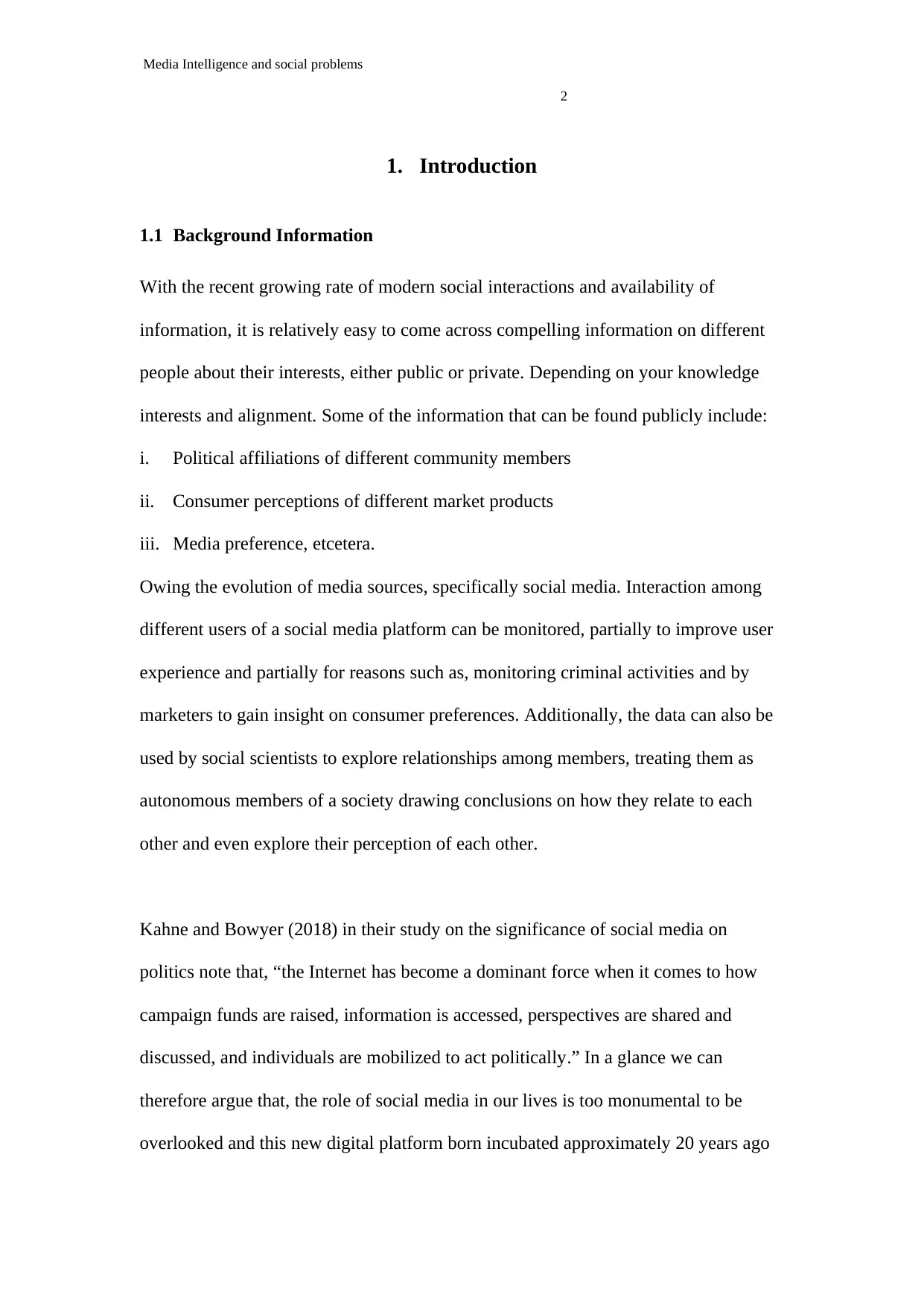
2
Media Intelligence and social problems
1. Introduction
1.1 Background Information
With the recent growing rate of modern social interactions and availability of
information, it is relatively easy to come across compelling information on different
people about their interests, either public or private. Depending on your knowledge
interests and alignment. Some of the information that can be found publicly include:
i. Political affiliations of different community members
ii. Consumer perceptions of different market products
iii. Media preference, etcetera.
Owing the evolution of media sources, specifically social media. Interaction among
different users of a social media platform can be monitored, partially to improve user
experience and partially for reasons such as, monitoring criminal activities and by
marketers to gain insight on consumer preferences. Additionally, the data can also be
used by social scientists to explore relationships among members, treating them as
autonomous members of a society drawing conclusions on how they relate to each
other and even explore their perception of each other.
Kahne and Bowyer (2018) in their study on the significance of social media on
politics note that, “the Internet has become a dominant force when it comes to how
campaign funds are raised, information is accessed, perspectives are shared and
discussed, and individuals are mobilized to act politically.” In a glance we can
therefore argue that, the role of social media in our lives is too monumental to be
overlooked and this new digital platform born incubated approximately 20 years ago
Media Intelligence and social problems
1. Introduction
1.1 Background Information
With the recent growing rate of modern social interactions and availability of
information, it is relatively easy to come across compelling information on different
people about their interests, either public or private. Depending on your knowledge
interests and alignment. Some of the information that can be found publicly include:
i. Political affiliations of different community members
ii. Consumer perceptions of different market products
iii. Media preference, etcetera.
Owing the evolution of media sources, specifically social media. Interaction among
different users of a social media platform can be monitored, partially to improve user
experience and partially for reasons such as, monitoring criminal activities and by
marketers to gain insight on consumer preferences. Additionally, the data can also be
used by social scientists to explore relationships among members, treating them as
autonomous members of a society drawing conclusions on how they relate to each
other and even explore their perception of each other.
Kahne and Bowyer (2018) in their study on the significance of social media on
politics note that, “the Internet has become a dominant force when it comes to how
campaign funds are raised, information is accessed, perspectives are shared and
discussed, and individuals are mobilized to act politically.” In a glance we can
therefore argue that, the role of social media in our lives is too monumental to be
overlooked and this new digital platform born incubated approximately 20 years ago
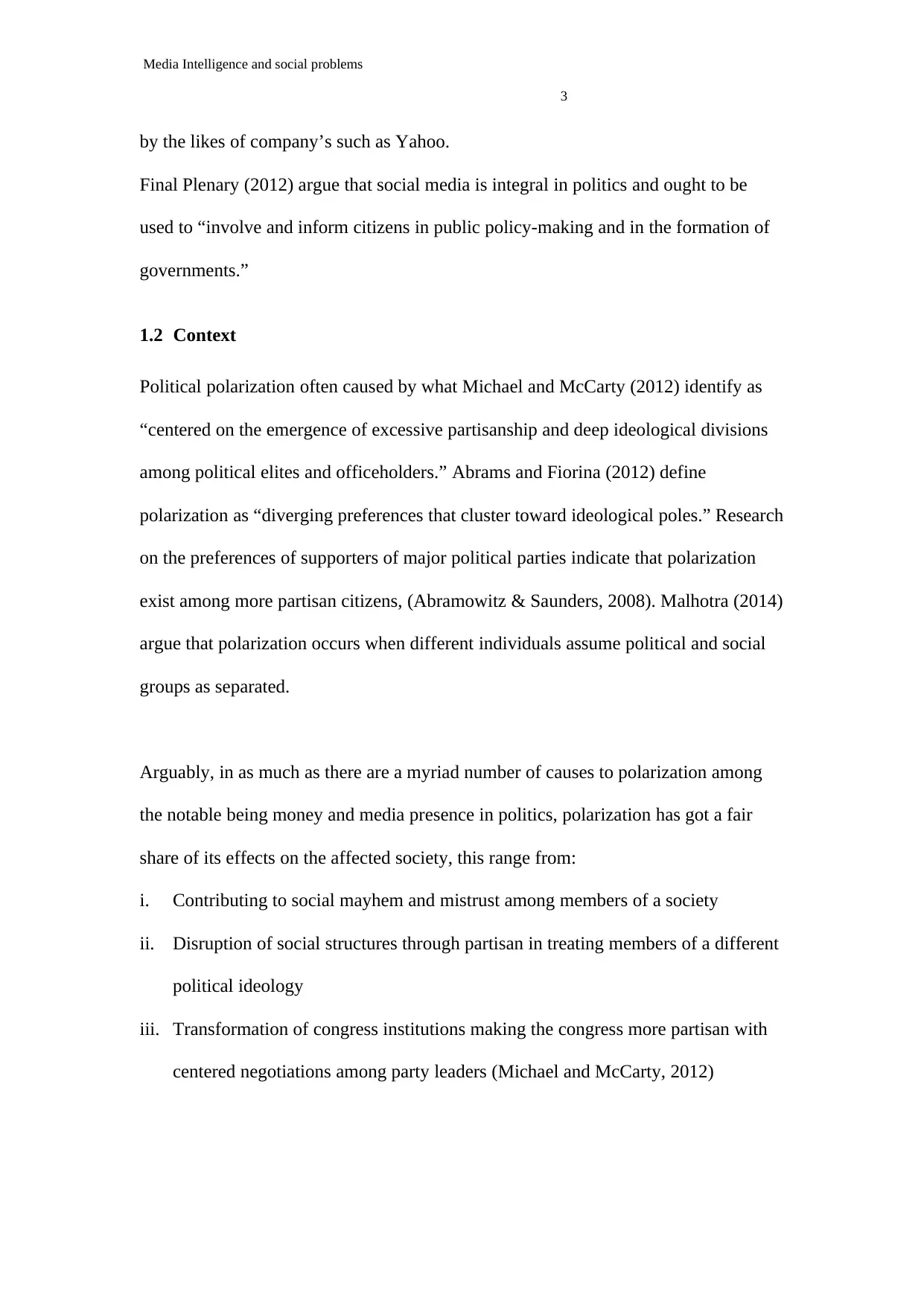
3
Media Intelligence and social problems
by the likes of company’s such as Yahoo.
Final Plenary (2012) argue that social media is integral in politics and ought to be
used to “involve and inform citizens in public policy-making and in the formation of
governments.”
1.2 Context
Political polarization often caused by what Michael and McCarty (2012) identify as
“centered on the emergence of excessive partisanship and deep ideological divisions
among political elites and officeholders.” Abrams and Fiorina (2012) define
polarization as “diverging preferences that cluster toward ideological poles.” Research
on the preferences of supporters of major political parties indicate that polarization
exist among more partisan citizens, (Abramowitz & Saunders, 2008). Malhotra (2014)
argue that polarization occurs when different individuals assume political and social
groups as separated.
Arguably, in as much as there are a myriad number of causes to polarization among
the notable being money and media presence in politics, polarization has got a fair
share of its effects on the affected society, this range from:
i. Contributing to social mayhem and mistrust among members of a society
ii. Disruption of social structures through partisan in treating members of a different
political ideology
iii. Transformation of congress institutions making the congress more partisan with
centered negotiations among party leaders (Michael and McCarty, 2012)
Media Intelligence and social problems
by the likes of company’s such as Yahoo.
Final Plenary (2012) argue that social media is integral in politics and ought to be
used to “involve and inform citizens in public policy-making and in the formation of
governments.”
1.2 Context
Political polarization often caused by what Michael and McCarty (2012) identify as
“centered on the emergence of excessive partisanship and deep ideological divisions
among political elites and officeholders.” Abrams and Fiorina (2012) define
polarization as “diverging preferences that cluster toward ideological poles.” Research
on the preferences of supporters of major political parties indicate that polarization
exist among more partisan citizens, (Abramowitz & Saunders, 2008). Malhotra (2014)
argue that polarization occurs when different individuals assume political and social
groups as separated.
Arguably, in as much as there are a myriad number of causes to polarization among
the notable being money and media presence in politics, polarization has got a fair
share of its effects on the affected society, this range from:
i. Contributing to social mayhem and mistrust among members of a society
ii. Disruption of social structures through partisan in treating members of a different
political ideology
iii. Transformation of congress institutions making the congress more partisan with
centered negotiations among party leaders (Michael and McCarty, 2012)
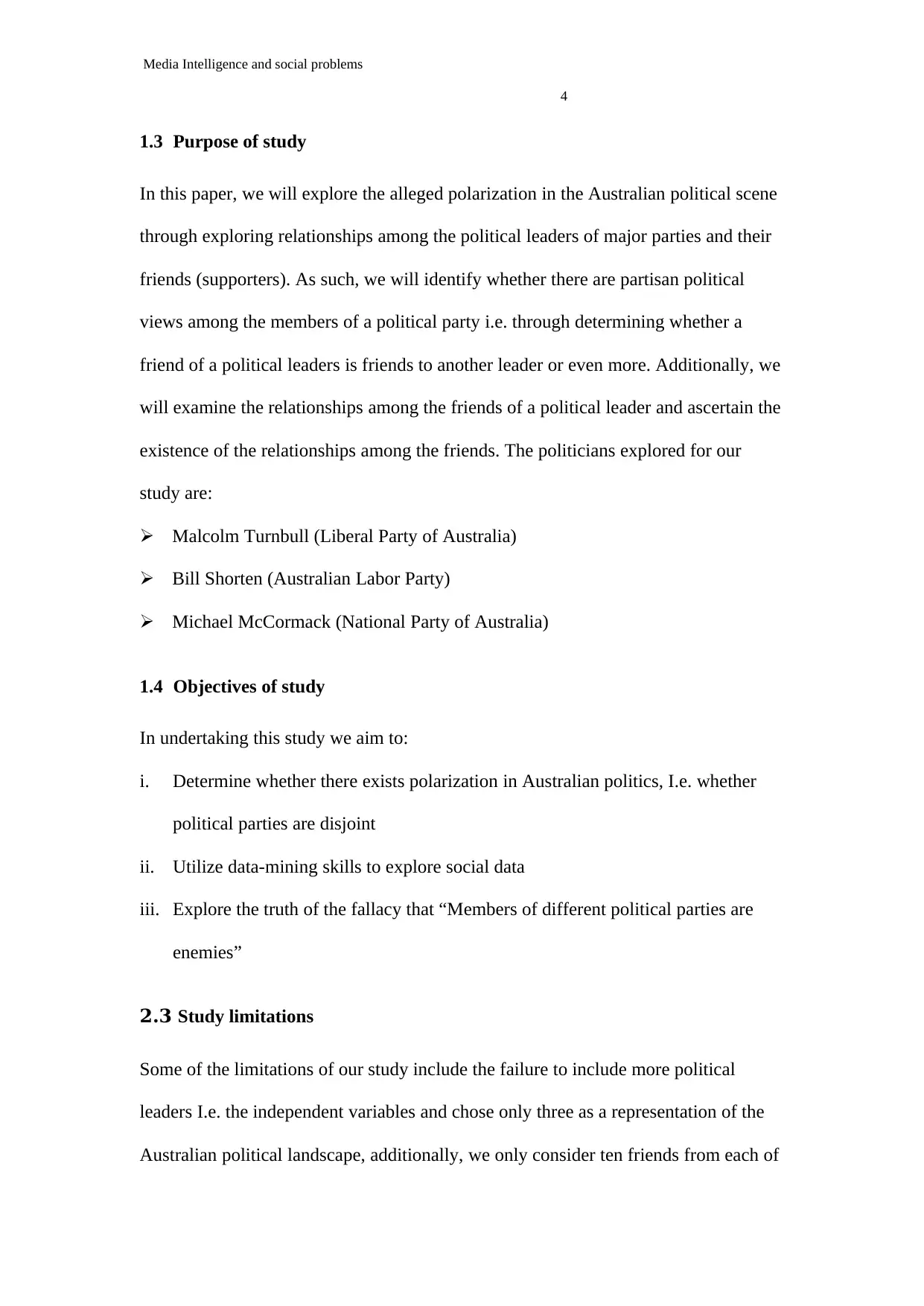
4
Media Intelligence and social problems
1.3 Purpose of study
In this paper, we will explore the alleged polarization in the Australian political scene
through exploring relationships among the political leaders of major parties and their
friends (supporters). As such, we will identify whether there are partisan political
views among the members of a political party i.e. through determining whether a
friend of a political leaders is friends to another leader or even more. Additionally, we
will examine the relationships among the friends of a political leader and ascertain the
existence of the relationships among the friends. The politicians explored for our
study are:
Malcolm Turnbull (Liberal Party of Australia)
Bill Shorten (Australian Labor Party)
Michael McCormack (National Party of Australia)
1.4 Objectives of study
In undertaking this study we aim to:
i. Determine whether there exists polarization in Australian politics, I.e. whether
political parties are disjoint
ii. Utilize data-mining skills to explore social data
iii. Explore the truth of the fallacy that “Members of different political parties are
enemies”
2.3 Study limitations
Some of the limitations of our study include the failure to include more political
leaders I.e. the independent variables and chose only three as a representation of the
Australian political landscape, additionally, we only consider ten friends from each of
Media Intelligence and social problems
1.3 Purpose of study
In this paper, we will explore the alleged polarization in the Australian political scene
through exploring relationships among the political leaders of major parties and their
friends (supporters). As such, we will identify whether there are partisan political
views among the members of a political party i.e. through determining whether a
friend of a political leaders is friends to another leader or even more. Additionally, we
will examine the relationships among the friends of a political leader and ascertain the
existence of the relationships among the friends. The politicians explored for our
study are:
Malcolm Turnbull (Liberal Party of Australia)
Bill Shorten (Australian Labor Party)
Michael McCormack (National Party of Australia)
1.4 Objectives of study
In undertaking this study we aim to:
i. Determine whether there exists polarization in Australian politics, I.e. whether
political parties are disjoint
ii. Utilize data-mining skills to explore social data
iii. Explore the truth of the fallacy that “Members of different political parties are
enemies”
2.3 Study limitations
Some of the limitations of our study include the failure to include more political
leaders I.e. the independent variables and chose only three as a representation of the
Australian political landscape, additionally, we only consider ten friends from each of
Secure Best Marks with AI Grader
Need help grading? Try our AI Grader for instant feedback on your assignments.

5
Media Intelligence and social problems
the three politicians i.e n=30 which statistically is an inadequate sample to represent a
population.
Media Intelligence and social problems
the three politicians i.e n=30 which statistically is an inadequate sample to represent a
population.
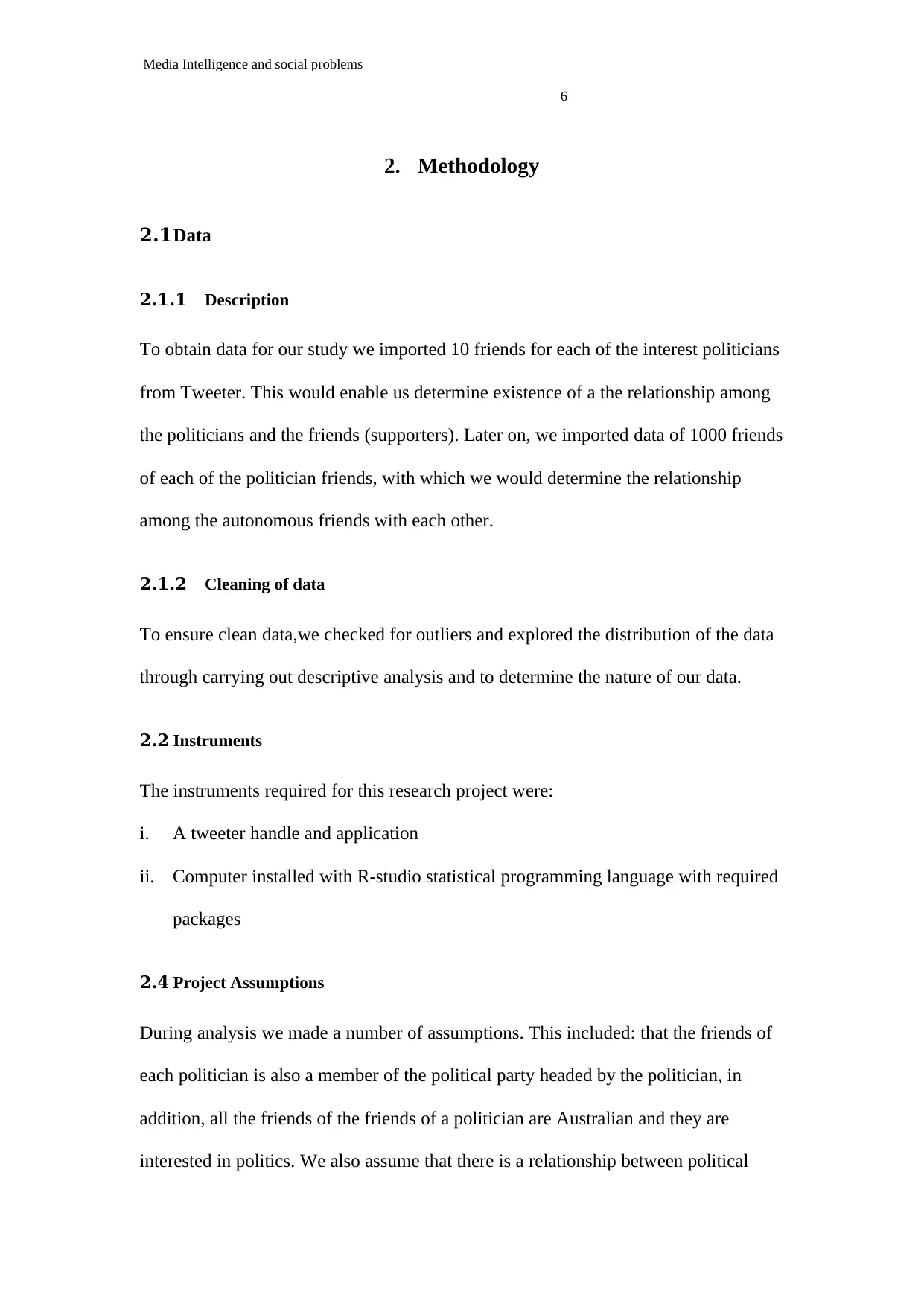
6
Media Intelligence and social problems
2. Methodology
2.1Data
2.1.1 Description
To obtain data for our study we imported 10 friends for each of the interest politicians
from Tweeter. This would enable us determine existence of a the relationship among
the politicians and the friends (supporters). Later on, we imported data of 1000 friends
of each of the politician friends, with which we would determine the relationship
among the autonomous friends with each other.
2.1.2 Cleaning of data
To ensure clean data,we checked for outliers and explored the distribution of the data
through carrying out descriptive analysis and to determine the nature of our data.
2.2 Instruments
The instruments required for this research project were:
i. A tweeter handle and application
ii. Computer installed with R-studio statistical programming language with required
packages
2.4 Project Assumptions
During analysis we made a number of assumptions. This included: that the friends of
each politician is also a member of the political party headed by the politician, in
addition, all the friends of the friends of a politician are Australian and they are
interested in politics. We also assume that there is a relationship between political
Media Intelligence and social problems
2. Methodology
2.1Data
2.1.1 Description
To obtain data for our study we imported 10 friends for each of the interest politicians
from Tweeter. This would enable us determine existence of a the relationship among
the politicians and the friends (supporters). Later on, we imported data of 1000 friends
of each of the politician friends, with which we would determine the relationship
among the autonomous friends with each other.
2.1.2 Cleaning of data
To ensure clean data,we checked for outliers and explored the distribution of the data
through carrying out descriptive analysis and to determine the nature of our data.
2.2 Instruments
The instruments required for this research project were:
i. A tweeter handle and application
ii. Computer installed with R-studio statistical programming language with required
packages
2.4 Project Assumptions
During analysis we made a number of assumptions. This included: that the friends of
each politician is also a member of the political party headed by the politician, in
addition, all the friends of the friends of a politician are Australian and they are
interested in politics. We also assume that there is a relationship between political
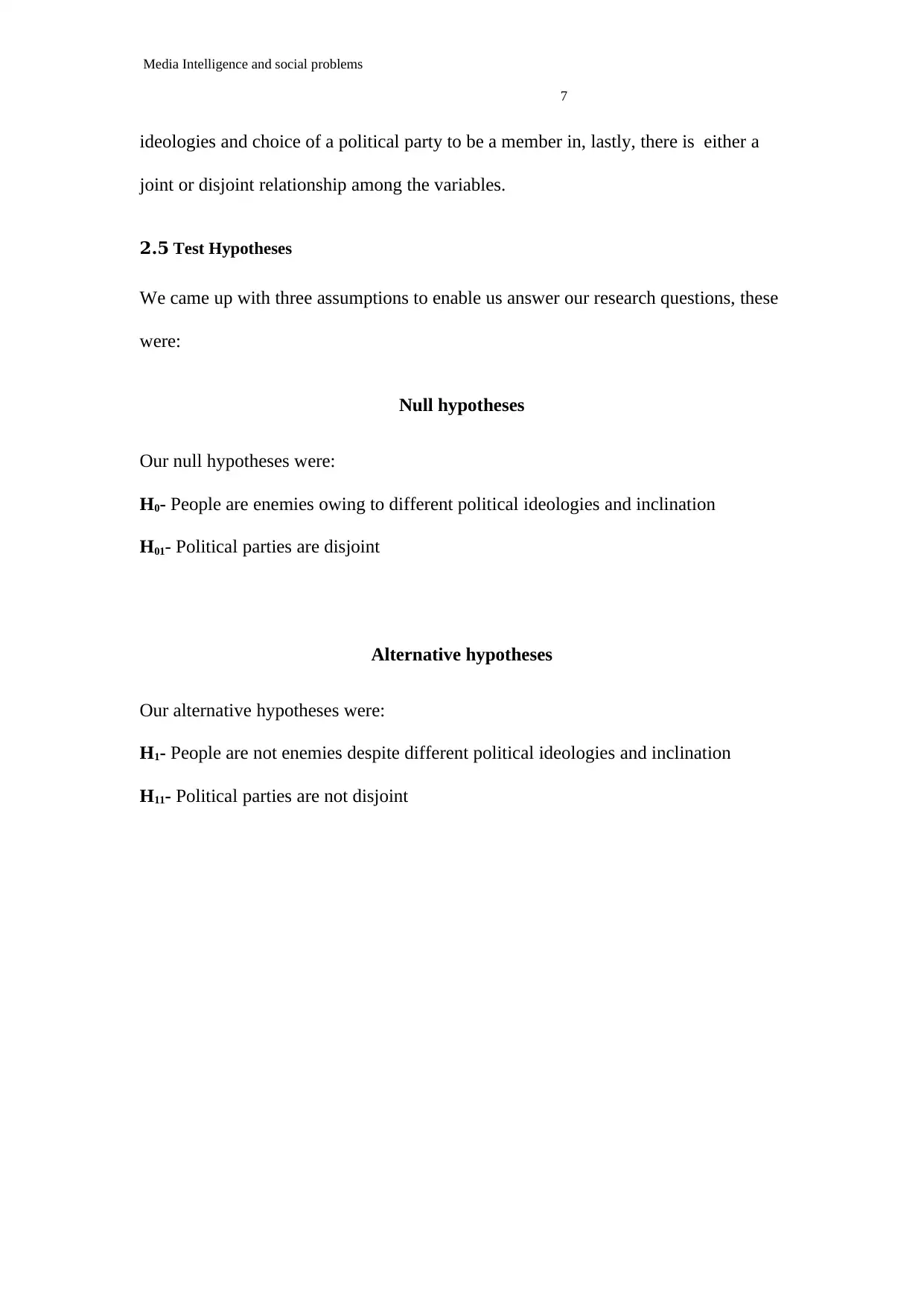
7
Media Intelligence and social problems
ideologies and choice of a political party to be a member in, lastly, there is either a
joint or disjoint relationship among the variables.
2.5 Test Hypotheses
We came up with three assumptions to enable us answer our research questions, these
were:
Null hypotheses
Our null hypotheses were:
H0- People are enemies owing to different political ideologies and inclination
H01- Political parties are disjoint
Alternative hypotheses
Our alternative hypotheses were:
H1- People are not enemies despite different political ideologies and inclination
H11- Political parties are not disjoint
Media Intelligence and social problems
ideologies and choice of a political party to be a member in, lastly, there is either a
joint or disjoint relationship among the variables.
2.5 Test Hypotheses
We came up with three assumptions to enable us answer our research questions, these
were:
Null hypotheses
Our null hypotheses were:
H0- People are enemies owing to different political ideologies and inclination
H01- Political parties are disjoint
Alternative hypotheses
Our alternative hypotheses were:
H1- People are not enemies despite different political ideologies and inclination
H11- Political parties are not disjoint
Paraphrase This Document
Need a fresh take? Get an instant paraphrase of this document with our AI Paraphraser
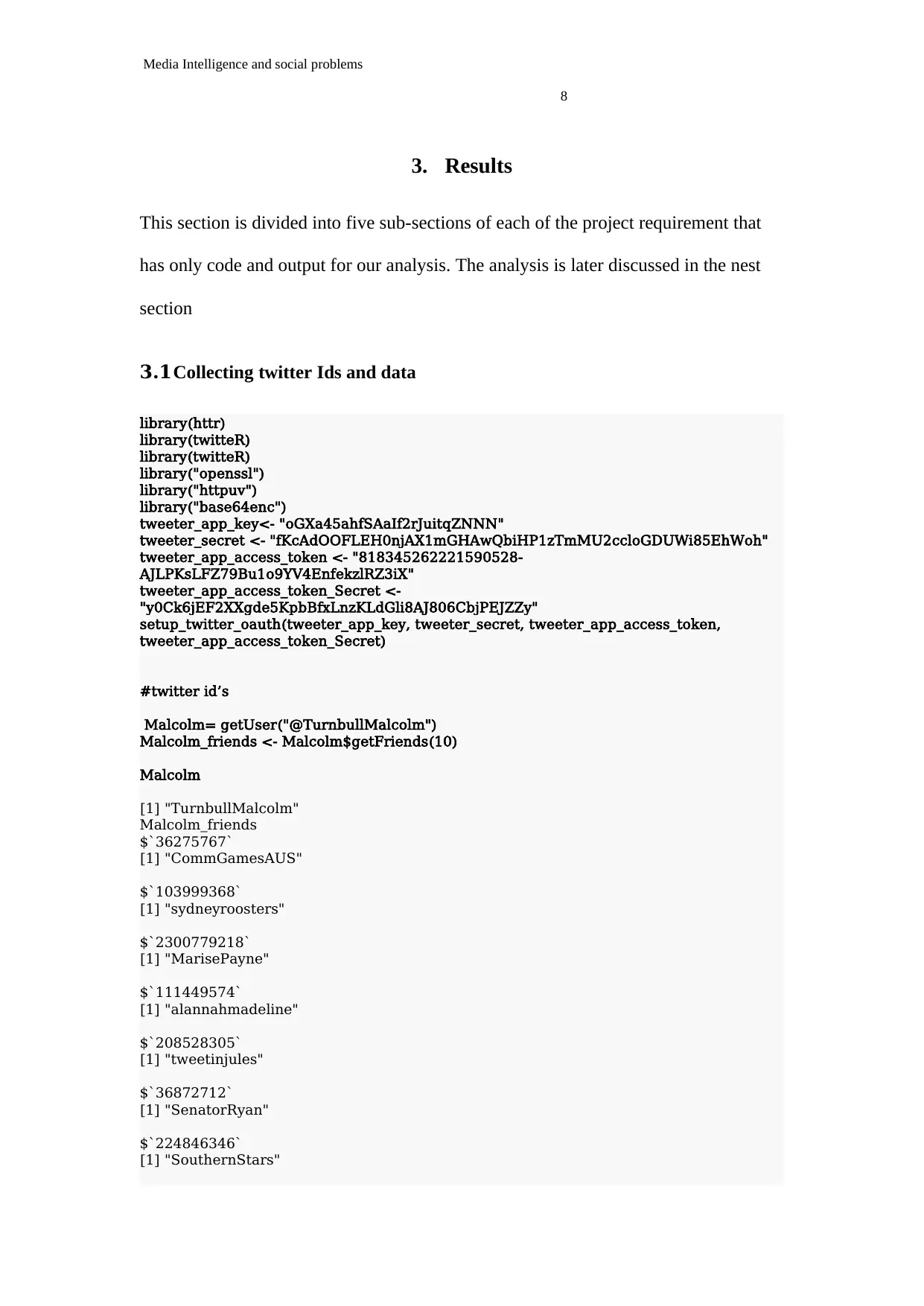
8
Media Intelligence and social problems
3. Results
This section is divided into five sub-sections of each of the project requirement that
has only code and output for our analysis. The analysis is later discussed in the nest
section
3.1Collecting twitter Ids and data
library(httr)
library(twitteR)
library(twitteR)
library("openssl")
library("httpuv")
library("base64enc")
tweeter_app_key<- "oGXa45ahfSAaIf2rJuitqZNNN"
tweeter_secret <- "fKcAdOOFLEH0njAX1mGHAwQbiHP1zTmMU2ccloGDUWi85EhWoh"
tweeter_app_access_token <- "818345262221590528-
AJLPKsLFZ79Bu1o9YV4EnfekzlRZ3iX"
tweeter_app_access_token_Secret <-
"y0Ck6jEF2XXgde5KpbBfxLnzKLdGli8AJ806CbjPEJZZy"
setup_twitter_oauth(tweeter_app_key, tweeter_secret, tweeter_app_access_token,
tweeter_app_access_token_Secret)
#twitter id’s
Malcolm= getUser("@TurnbullMalcolm")
Malcolm_friends <- Malcolm$getFriends(10)
Malcolm
[1] "TurnbullMalcolm"
Malcolm_friends
$`36275767`
[1] "CommGamesAUS"
$`103999368`
[1] "sydneyroosters"
$`2300779218`
[1] "MarisePayne"
$`111449574`
[1] "alannahmadeline"
$`208528305`
[1] "tweetinjules"
$`36872712`
[1] "SenatorRyan"
$`224846346`
[1] "SouthernStars"
Media Intelligence and social problems
3. Results
This section is divided into five sub-sections of each of the project requirement that
has only code and output for our analysis. The analysis is later discussed in the nest
section
3.1Collecting twitter Ids and data
library(httr)
library(twitteR)
library(twitteR)
library("openssl")
library("httpuv")
library("base64enc")
tweeter_app_key<- "oGXa45ahfSAaIf2rJuitqZNNN"
tweeter_secret <- "fKcAdOOFLEH0njAX1mGHAwQbiHP1zTmMU2ccloGDUWi85EhWoh"
tweeter_app_access_token <- "818345262221590528-
AJLPKsLFZ79Bu1o9YV4EnfekzlRZ3iX"
tweeter_app_access_token_Secret <-
"y0Ck6jEF2XXgde5KpbBfxLnzKLdGli8AJ806CbjPEJZZy"
setup_twitter_oauth(tweeter_app_key, tweeter_secret, tweeter_app_access_token,
tweeter_app_access_token_Secret)
#twitter id’s
Malcolm= getUser("@TurnbullMalcolm")
Malcolm_friends <- Malcolm$getFriends(10)
Malcolm
[1] "TurnbullMalcolm"
Malcolm_friends
$`36275767`
[1] "CommGamesAUS"
$`103999368`
[1] "sydneyroosters"
$`2300779218`
[1] "MarisePayne"
$`111449574`
[1] "alannahmadeline"
$`208528305`
[1] "tweetinjules"
$`36872712`
[1] "SenatorRyan"
$`224846346`
[1] "SouthernStars"
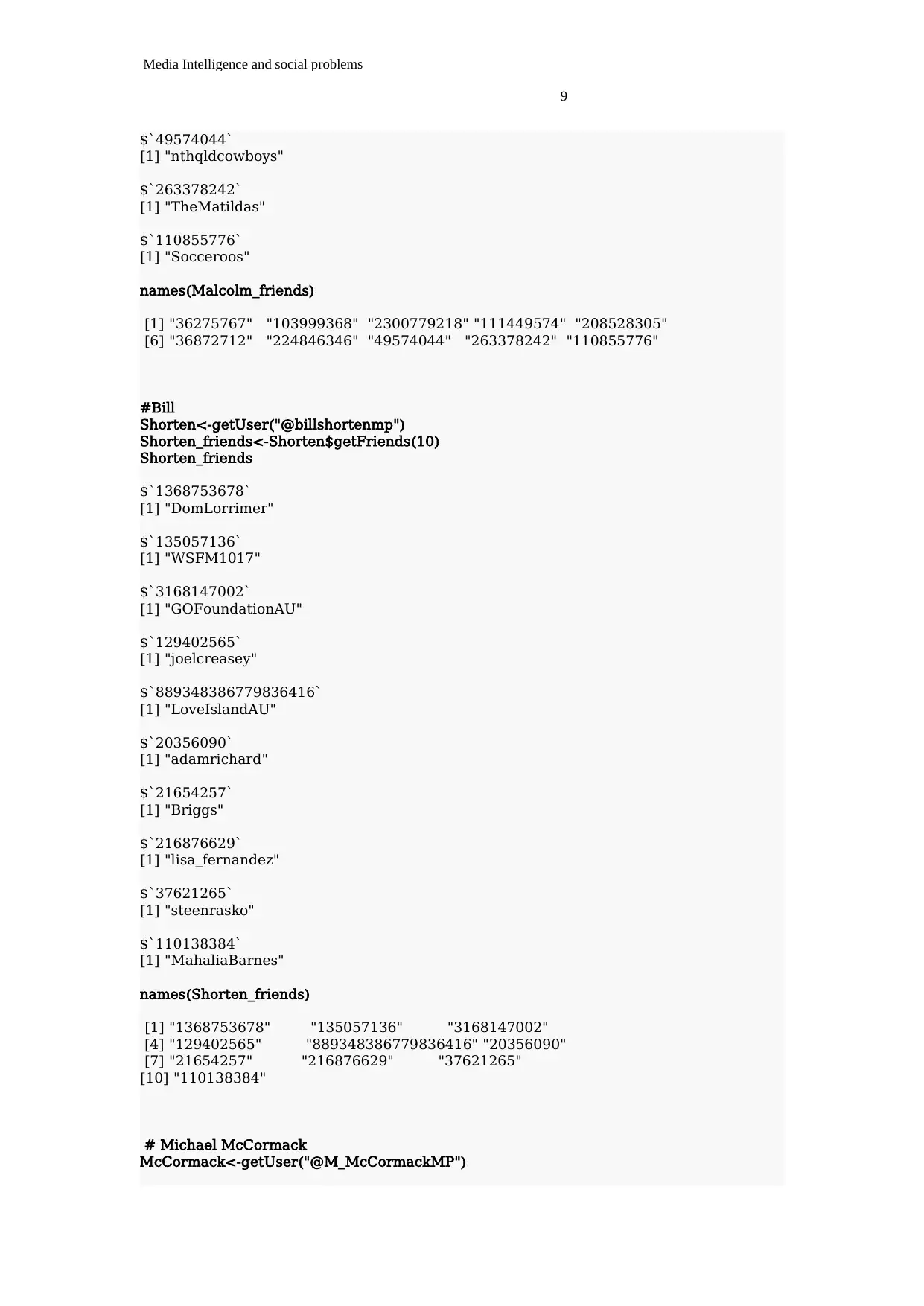
9
Media Intelligence and social problems
$`49574044`
[1] "nthqldcowboys"
$`263378242`
[1] "TheMatildas"
$`110855776`
[1] "Socceroos"
names(Malcolm_friends)
[1] "36275767" "103999368" "2300779218" "111449574" "208528305"
[6] "36872712" "224846346" "49574044" "263378242" "110855776"
#Bill
Shorten<-getUser("@billshortenmp")
Shorten_friends<-Shorten$getFriends(10)
Shorten_friends
$`1368753678`
[1] "DomLorrimer"
$`135057136`
[1] "WSFM1017"
$`3168147002`
[1] "GOFoundationAU"
$`129402565`
[1] "joelcreasey"
$`889348386779836416`
[1] "LoveIslandAU"
$`20356090`
[1] "adamrichard"
$`21654257`
[1] "Briggs"
$`216876629`
[1] "lisa_fernandez"
$`37621265`
[1] "steenrasko"
$`110138384`
[1] "MahaliaBarnes"
names(Shorten_friends)
[1] "1368753678" "135057136" "3168147002"
[4] "129402565" "889348386779836416" "20356090"
[7] "21654257" "216876629" "37621265"
[10] "110138384"
# Michael McCormack
McCormack<-getUser("@M_McCormackMP")
Media Intelligence and social problems
$`49574044`
[1] "nthqldcowboys"
$`263378242`
[1] "TheMatildas"
$`110855776`
[1] "Socceroos"
names(Malcolm_friends)
[1] "36275767" "103999368" "2300779218" "111449574" "208528305"
[6] "36872712" "224846346" "49574044" "263378242" "110855776"
#Bill
Shorten<-getUser("@billshortenmp")
Shorten_friends<-Shorten$getFriends(10)
Shorten_friends
$`1368753678`
[1] "DomLorrimer"
$`135057136`
[1] "WSFM1017"
$`3168147002`
[1] "GOFoundationAU"
$`129402565`
[1] "joelcreasey"
$`889348386779836416`
[1] "LoveIslandAU"
$`20356090`
[1] "adamrichard"
$`21654257`
[1] "Briggs"
$`216876629`
[1] "lisa_fernandez"
$`37621265`
[1] "steenrasko"
$`110138384`
[1] "MahaliaBarnes"
names(Shorten_friends)
[1] "1368753678" "135057136" "3168147002"
[4] "129402565" "889348386779836416" "20356090"
[7] "21654257" "216876629" "37621265"
[10] "110138384"
# Michael McCormack
McCormack<-getUser("@M_McCormackMP")
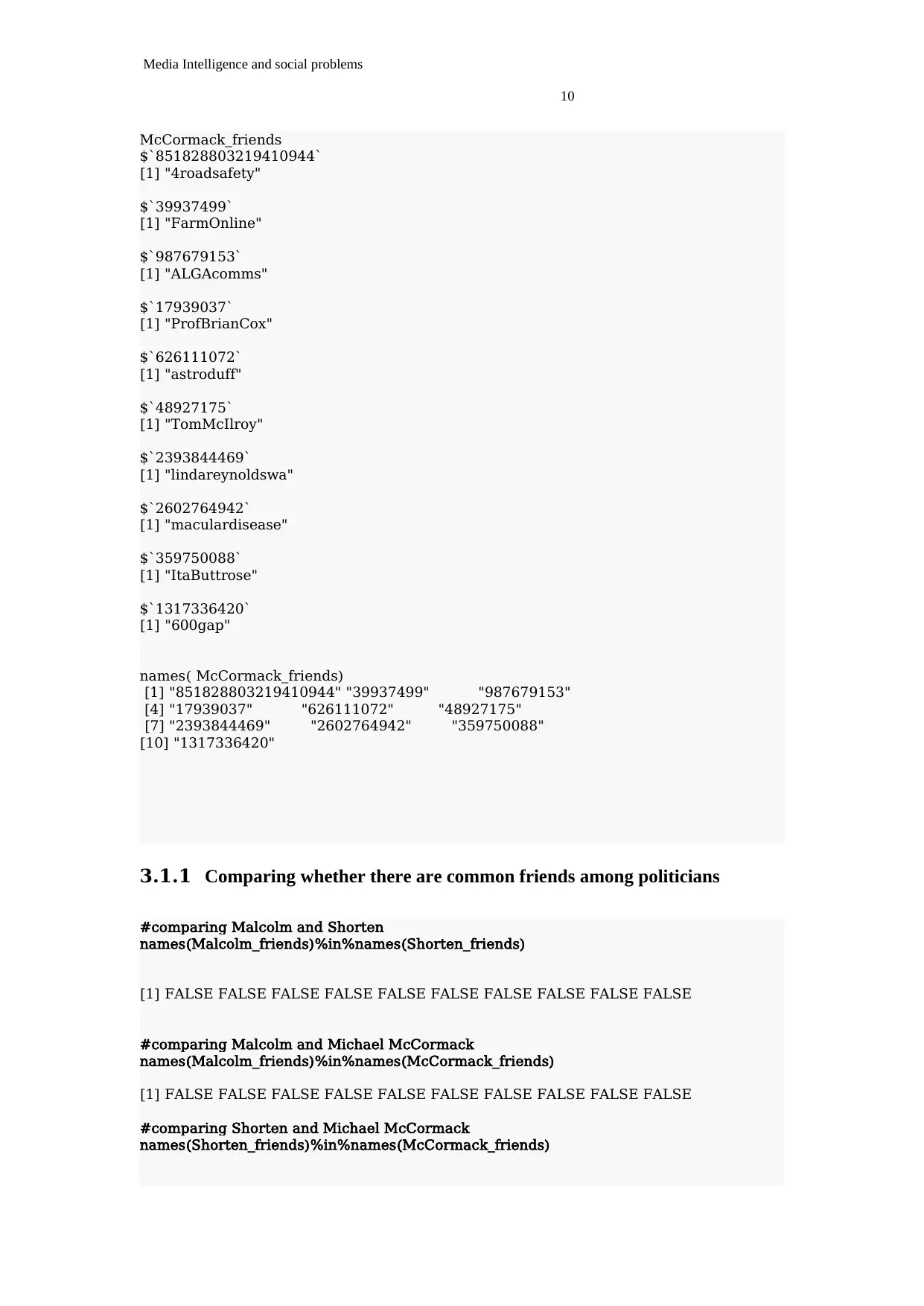
10
Media Intelligence and social problems
McCormack_friends
$`851828803219410944`
[1] "4roadsafety"
$`39937499`
[1] "FarmOnline"
$`987679153`
[1] "ALGAcomms"
$`17939037`
[1] "ProfBrianCox"
$`626111072`
[1] "astroduff"
$`48927175`
[1] "TomMcIlroy"
$`2393844469`
[1] "lindareynoldswa"
$`2602764942`
[1] "maculardisease"
$`359750088`
[1] "ItaButtrose"
$`1317336420`
[1] "600gap"
names( McCormack_friends)
[1] "851828803219410944" "39937499" "987679153"
[4] "17939037" "626111072" "48927175"
[7] "2393844469" "2602764942" "359750088"
[10] "1317336420"
3.1.1 Comparing whether there are common friends among politicians
#comparing Malcolm and Shorten
names(Malcolm_friends)%in%names(Shorten_friends)
[1] FALSE FALSE FALSE FALSE FALSE FALSE FALSE FALSE FALSE FALSE
#comparing Malcolm and Michael McCormack
names(Malcolm_friends)%in%names(McCormack_friends)
[1] FALSE FALSE FALSE FALSE FALSE FALSE FALSE FALSE FALSE FALSE
#comparing Shorten and Michael McCormack
names(Shorten_friends)%in%names(McCormack_friends)
Media Intelligence and social problems
McCormack_friends
$`851828803219410944`
[1] "4roadsafety"
$`39937499`
[1] "FarmOnline"
$`987679153`
[1] "ALGAcomms"
$`17939037`
[1] "ProfBrianCox"
$`626111072`
[1] "astroduff"
$`48927175`
[1] "TomMcIlroy"
$`2393844469`
[1] "lindareynoldswa"
$`2602764942`
[1] "maculardisease"
$`359750088`
[1] "ItaButtrose"
$`1317336420`
[1] "600gap"
names( McCormack_friends)
[1] "851828803219410944" "39937499" "987679153"
[4] "17939037" "626111072" "48927175"
[7] "2393844469" "2602764942" "359750088"
[10] "1317336420"
3.1.1 Comparing whether there are common friends among politicians
#comparing Malcolm and Shorten
names(Malcolm_friends)%in%names(Shorten_friends)
[1] FALSE FALSE FALSE FALSE FALSE FALSE FALSE FALSE FALSE FALSE
#comparing Malcolm and Michael McCormack
names(Malcolm_friends)%in%names(McCormack_friends)
[1] FALSE FALSE FALSE FALSE FALSE FALSE FALSE FALSE FALSE FALSE
#comparing Shorten and Michael McCormack
names(Shorten_friends)%in%names(McCormack_friends)
Secure Best Marks with AI Grader
Need help grading? Try our AI Grader for instant feedback on your assignments.
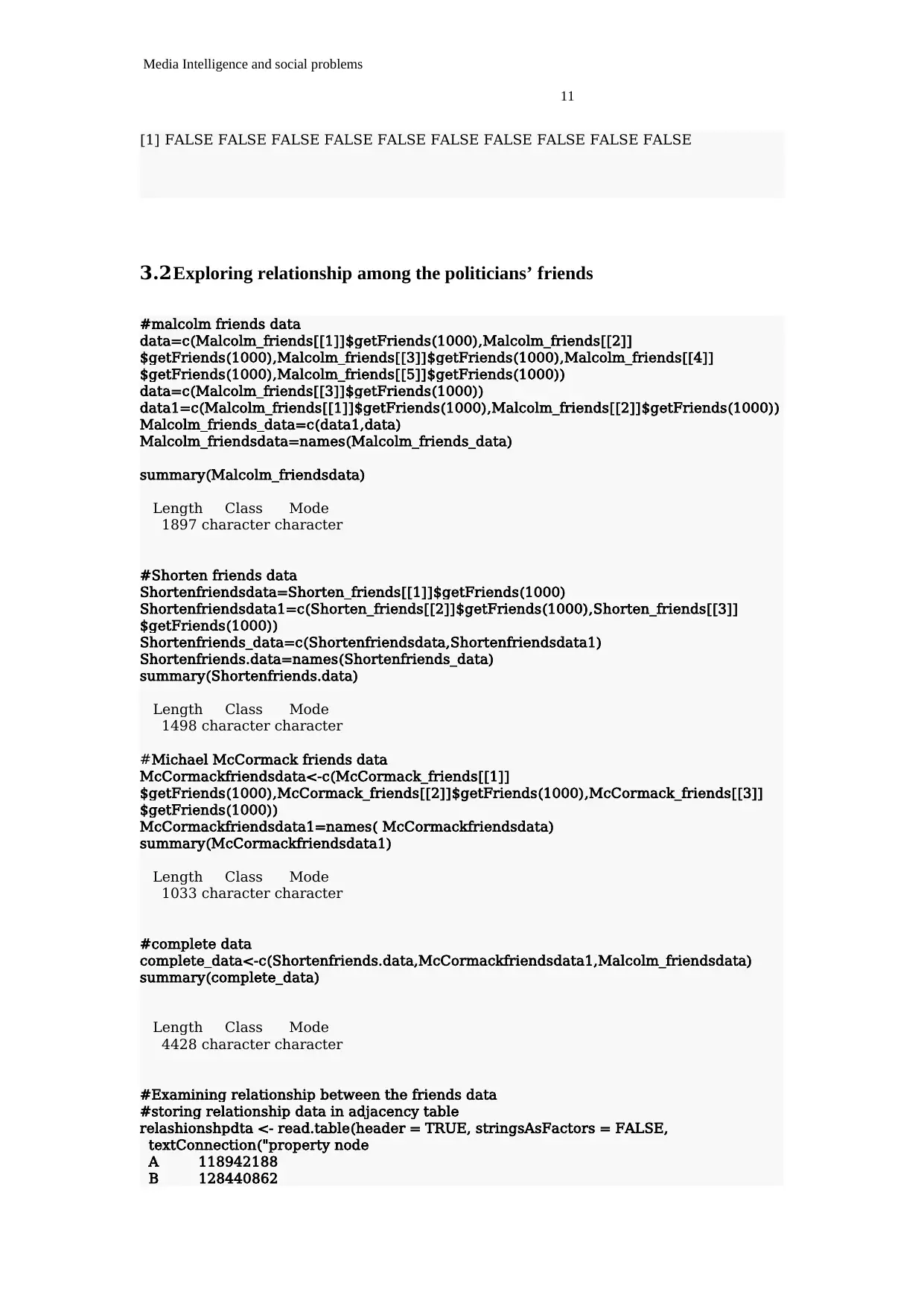
11
Media Intelligence and social problems
[1] FALSE FALSE FALSE FALSE FALSE FALSE FALSE FALSE FALSE FALSE
3.2Exploring relationship among the politicians’ friends
#malcolm friends data
data=c(Malcolm_friends[[1]]$getFriends(1000),Malcolm_friends[[2]]
$getFriends(1000),Malcolm_friends[[3]]$getFriends(1000),Malcolm_friends[[4]]
$getFriends(1000),Malcolm_friends[[5]]$getFriends(1000))
data=c(Malcolm_friends[[3]]$getFriends(1000))
data1=c(Malcolm_friends[[1]]$getFriends(1000),Malcolm_friends[[2]]$getFriends(1000))
Malcolm_friends_data=c(data1,data)
Malcolm_friendsdata=names(Malcolm_friends_data)
summary(Malcolm_friendsdata)
Length Class Mode
1897 character character
#Shorten friends data
Shortenfriendsdata=Shorten_friends[[1]]$getFriends(1000)
Shortenfriendsdata1=c(Shorten_friends[[2]]$getFriends(1000),Shorten_friends[[3]]
$getFriends(1000))
Shortenfriends_data=c(Shortenfriendsdata,Shortenfriendsdata1)
Shortenfriends.data=names(Shortenfriends_data)
summary(Shortenfriends.data)
Length Class Mode
1498 character character
#Michael McCormack friends data
McCormackfriendsdata<-c(McCormack_friends[[1]]
$getFriends(1000),McCormack_friends[[2]]$getFriends(1000),McCormack_friends[[3]]
$getFriends(1000))
McCormackfriendsdata1=names( McCormackfriendsdata)
summary(McCormackfriendsdata1)
Length Class Mode
1033 character character
#complete data
complete_data<-c(Shortenfriends.data,McCormackfriendsdata1,Malcolm_friendsdata)
summary(complete_data)
Length Class Mode
4428 character character
#Examining relationship between the friends data
#storing relationship data in adjacency table
relashionshpdta <- read.table(header = TRUE, stringsAsFactors = FALSE,
textConnection("property node
A 118942188
B 128440862
Media Intelligence and social problems
[1] FALSE FALSE FALSE FALSE FALSE FALSE FALSE FALSE FALSE FALSE
3.2Exploring relationship among the politicians’ friends
#malcolm friends data
data=c(Malcolm_friends[[1]]$getFriends(1000),Malcolm_friends[[2]]
$getFriends(1000),Malcolm_friends[[3]]$getFriends(1000),Malcolm_friends[[4]]
$getFriends(1000),Malcolm_friends[[5]]$getFriends(1000))
data=c(Malcolm_friends[[3]]$getFriends(1000))
data1=c(Malcolm_friends[[1]]$getFriends(1000),Malcolm_friends[[2]]$getFriends(1000))
Malcolm_friends_data=c(data1,data)
Malcolm_friendsdata=names(Malcolm_friends_data)
summary(Malcolm_friendsdata)
Length Class Mode
1897 character character
#Shorten friends data
Shortenfriendsdata=Shorten_friends[[1]]$getFriends(1000)
Shortenfriendsdata1=c(Shorten_friends[[2]]$getFriends(1000),Shorten_friends[[3]]
$getFriends(1000))
Shortenfriends_data=c(Shortenfriendsdata,Shortenfriendsdata1)
Shortenfriends.data=names(Shortenfriends_data)
summary(Shortenfriends.data)
Length Class Mode
1498 character character
#Michael McCormack friends data
McCormackfriendsdata<-c(McCormack_friends[[1]]
$getFriends(1000),McCormack_friends[[2]]$getFriends(1000),McCormack_friends[[3]]
$getFriends(1000))
McCormackfriendsdata1=names( McCormackfriendsdata)
summary(McCormackfriendsdata1)
Length Class Mode
1033 character character
#complete data
complete_data<-c(Shortenfriends.data,McCormackfriendsdata1,Malcolm_friendsdata)
summary(complete_data)
Length Class Mode
4428 character character
#Examining relationship between the friends data
#storing relationship data in adjacency table
relashionshpdta <- read.table(header = TRUE, stringsAsFactors = FALSE,
textConnection("property node
A 118942188
B 128440862
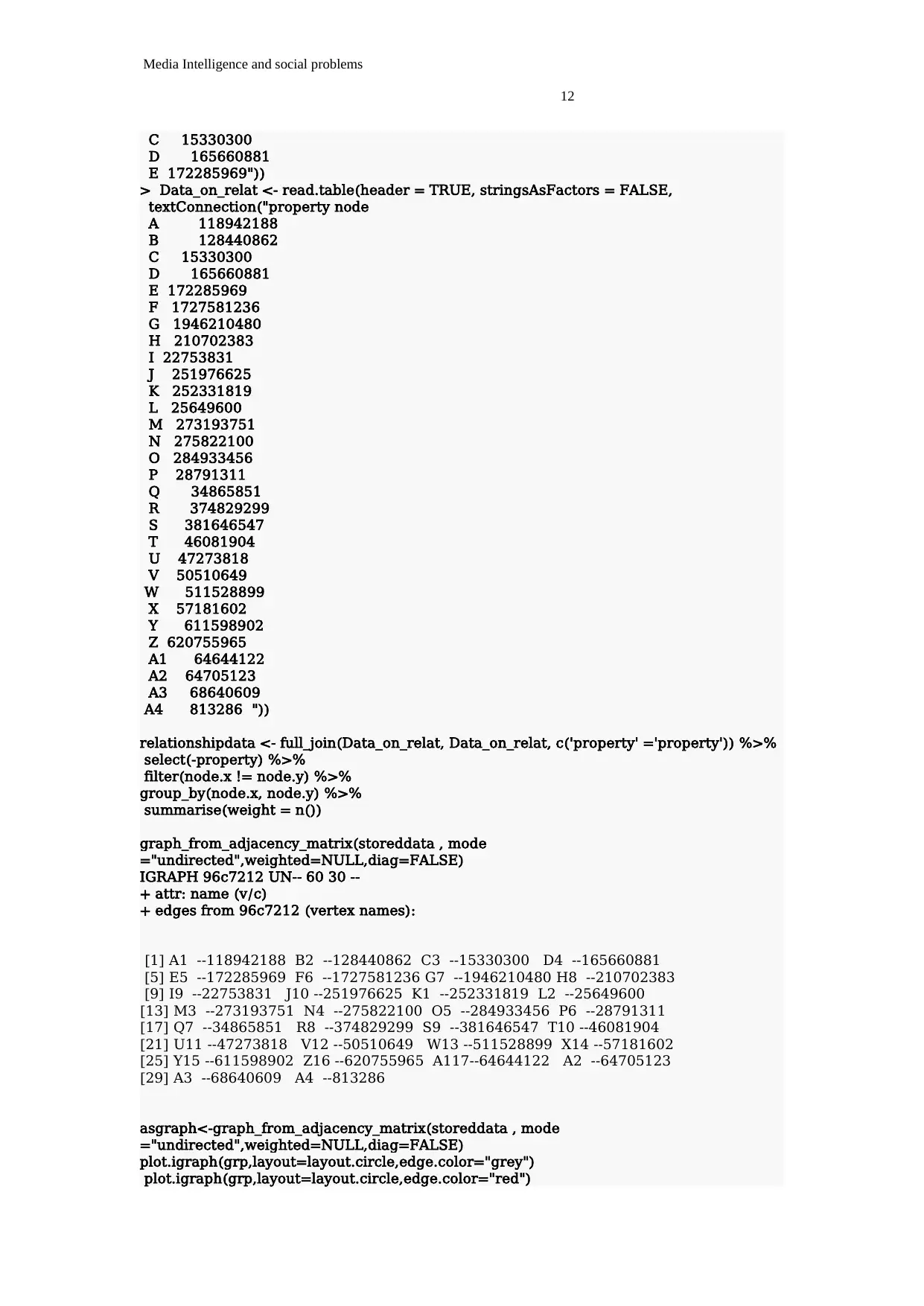
12
Media Intelligence and social problems
C 15330300
D 165660881
E 172285969"))
> Data_on_relat <- read.table(header = TRUE, stringsAsFactors = FALSE,
textConnection("property node
A 118942188
B 128440862
C 15330300
D 165660881
E 172285969
F 1727581236
G 1946210480
H 210702383
I 22753831
J 251976625
K 252331819
L 25649600
M 273193751
N 275822100
O 284933456
P 28791311
Q 34865851
R 374829299
S 381646547
T 46081904
U 47273818
V 50510649
W 511528899
X 57181602
Y 611598902
Z 620755965
A1 64644122
A2 64705123
A3 68640609
A4 813286 "))
relationshipdata <- full_join(Data_on_relat, Data_on_relat, c('property' ='property')) %>%
select(-property) %>%
filter(node.x != node.y) %>%
group_by(node.x, node.y) %>%
summarise(weight = n())
graph_from_adjacency_matrix(storeddata , mode
="undirected",weighted=NULL,diag=FALSE)
IGRAPH 96c7212 UN-- 60 30 --
+ attr: name (v/c)
+ edges from 96c7212 (vertex names):
[1] A1 --118942188 B2 --128440862 C3 --15330300 D4 --165660881
[5] E5 --172285969 F6 --1727581236 G7 --1946210480 H8 --210702383
[9] I9 --22753831 J10 --251976625 K1 --252331819 L2 --25649600
[13] M3 --273193751 N4 --275822100 O5 --284933456 P6 --28791311
[17] Q7 --34865851 R8 --374829299 S9 --381646547 T10 --46081904
[21] U11 --47273818 V12 --50510649 W13 --511528899 X14 --57181602
[25] Y15 --611598902 Z16 --620755965 A117--64644122 A2 --64705123
[29] A3 --68640609 A4 --813286
asgraph<-graph_from_adjacency_matrix(storeddata , mode
="undirected",weighted=NULL,diag=FALSE)
plot.igraph(grp,layout=layout.circle,edge.color="grey")
plot.igraph(grp,layout=layout.circle,edge.color="red")
Media Intelligence and social problems
C 15330300
D 165660881
E 172285969"))
> Data_on_relat <- read.table(header = TRUE, stringsAsFactors = FALSE,
textConnection("property node
A 118942188
B 128440862
C 15330300
D 165660881
E 172285969
F 1727581236
G 1946210480
H 210702383
I 22753831
J 251976625
K 252331819
L 25649600
M 273193751
N 275822100
O 284933456
P 28791311
Q 34865851
R 374829299
S 381646547
T 46081904
U 47273818
V 50510649
W 511528899
X 57181602
Y 611598902
Z 620755965
A1 64644122
A2 64705123
A3 68640609
A4 813286 "))
relationshipdata <- full_join(Data_on_relat, Data_on_relat, c('property' ='property')) %>%
select(-property) %>%
filter(node.x != node.y) %>%
group_by(node.x, node.y) %>%
summarise(weight = n())
graph_from_adjacency_matrix(storeddata , mode
="undirected",weighted=NULL,diag=FALSE)
IGRAPH 96c7212 UN-- 60 30 --
+ attr: name (v/c)
+ edges from 96c7212 (vertex names):
[1] A1 --118942188 B2 --128440862 C3 --15330300 D4 --165660881
[5] E5 --172285969 F6 --1727581236 G7 --1946210480 H8 --210702383
[9] I9 --22753831 J10 --251976625 K1 --252331819 L2 --25649600
[13] M3 --273193751 N4 --275822100 O5 --284933456 P6 --28791311
[17] Q7 --34865851 R8 --374829299 S9 --381646547 T10 --46081904
[21] U11 --47273818 V12 --50510649 W13 --511528899 X14 --57181602
[25] Y15 --611598902 Z16 --620755965 A117--64644122 A2 --64705123
[29] A3 --68640609 A4 --813286
asgraph<-graph_from_adjacency_matrix(storeddata , mode
="undirected",weighted=NULL,diag=FALSE)
plot.igraph(grp,layout=layout.circle,edge.color="grey")
plot.igraph(grp,layout=layout.circle,edge.color="red")
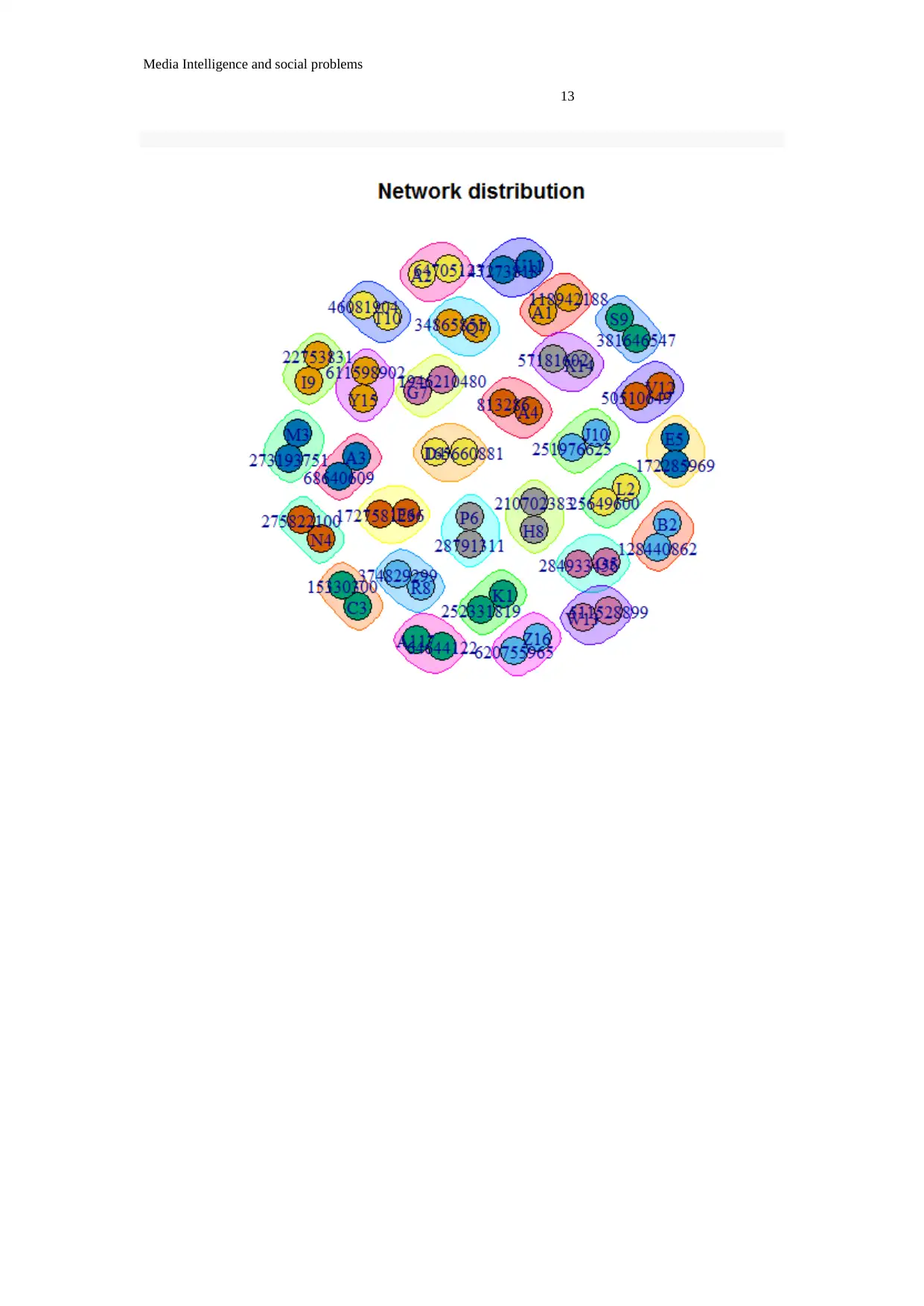
13
Media Intelligence and social problems
Media Intelligence and social problems
Paraphrase This Document
Need a fresh take? Get an instant paraphrase of this document with our AI Paraphraser
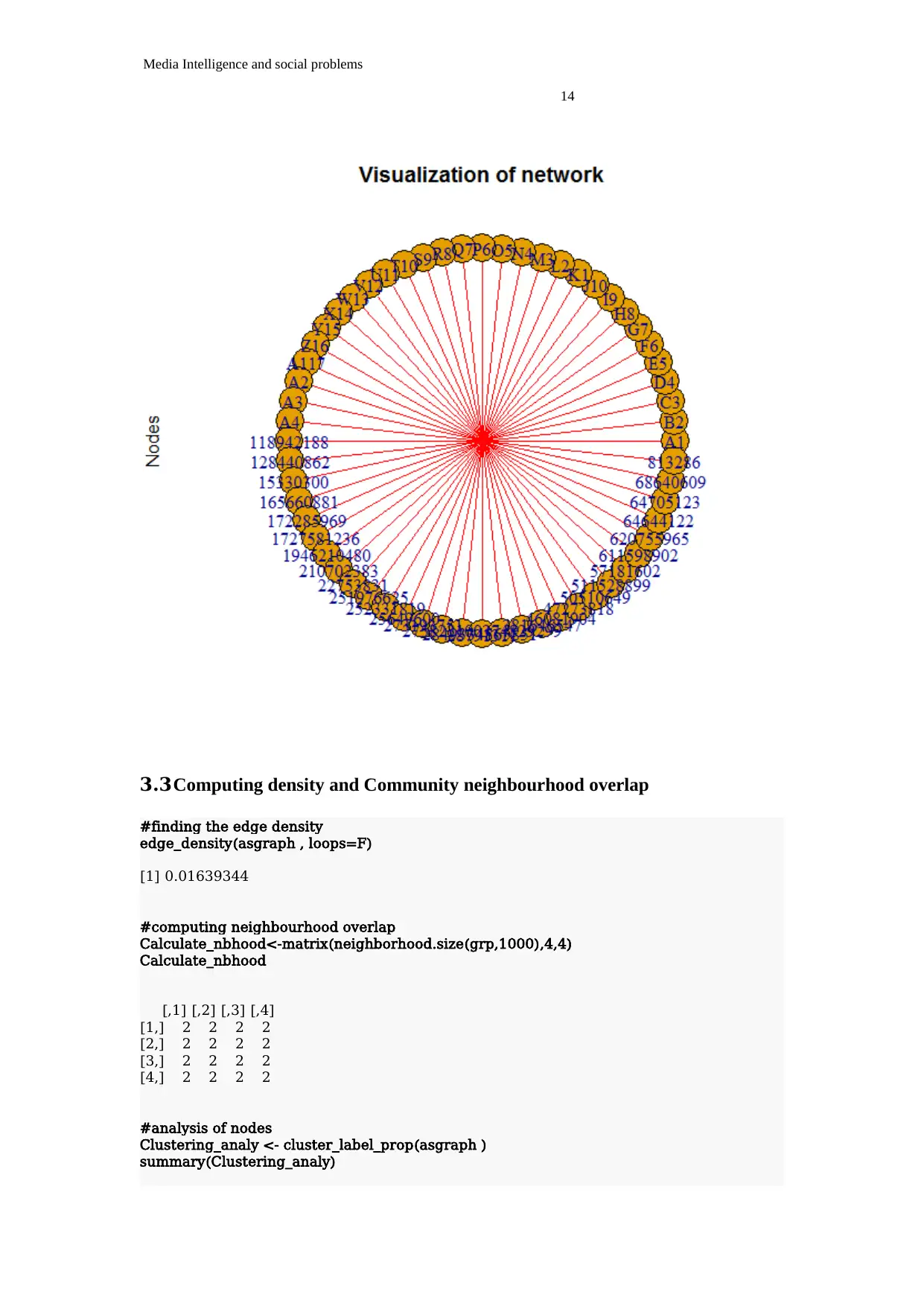
14
Media Intelligence and social problems
3.3Computing density and Community neighbourhood overlap
#finding the edge density
edge_density(asgraph , loops=F)
[1] 0.01639344
#computing neighbourhood overlap
Calculate_nbhood<-matrix(neighborhood.size(grp,1000),4,4)
Calculate_nbhood
[,1] [,2] [,3] [,4]
[1,] 2 2 2 2
[2,] 2 2 2 2
[3,] 2 2 2 2
[4,] 2 2 2 2
#analysis of nodes
Clustering_analy <- cluster_label_prop(asgraph )
summary(Clustering_analy)
Media Intelligence and social problems
3.3Computing density and Community neighbourhood overlap
#finding the edge density
edge_density(asgraph , loops=F)
[1] 0.01639344
#computing neighbourhood overlap
Calculate_nbhood<-matrix(neighborhood.size(grp,1000),4,4)
Calculate_nbhood
[,1] [,2] [,3] [,4]
[1,] 2 2 2 2
[2,] 2 2 2 2
[3,] 2 2 2 2
[4,] 2 2 2 2
#analysis of nodes
Clustering_analy <- cluster_label_prop(asgraph )
summary(Clustering_analy)
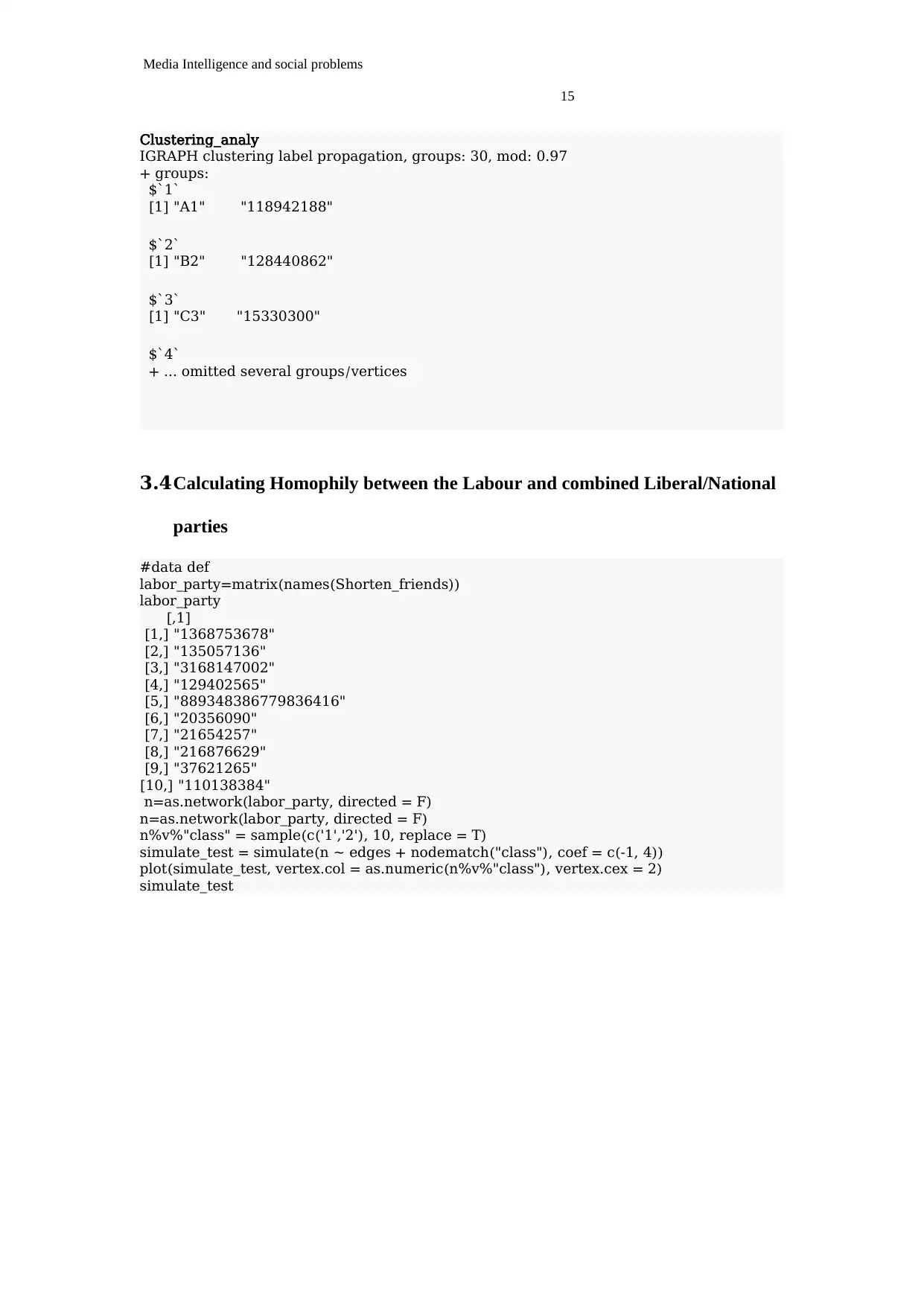
15
Media Intelligence and social problems
Clustering_analy
IGRAPH clustering label propagation, groups: 30, mod: 0.97
+ groups:
$`1`
[1] "A1" "118942188"
$`2`
[1] "B2" "128440862"
$`3`
[1] "C3" "15330300"
$`4`
+ ... omitted several groups/vertices
3.4Calculating Homophily between the Labour and combined Liberal/National
parties
#data def
labor_party=matrix(names(Shorten_friends))
labor_party
[,1]
[1,] "1368753678"
[2,] "135057136"
[3,] "3168147002"
[4,] "129402565"
[5,] "889348386779836416"
[6,] "20356090"
[7,] "21654257"
[8,] "216876629"
[9,] "37621265"
[10,] "110138384"
n=as.network(labor_party, directed = F)
n=as.network(labor_party, directed = F)
n%v%"class" = sample(c('1','2'), 10, replace = T)
simulate_test = simulate(n ~ edges + nodematch("class"), coef = c(-1, 4))
plot(simulate_test, vertex.col = as.numeric(n%v%"class"), vertex.cex = 2)
simulate_test
Media Intelligence and social problems
Clustering_analy
IGRAPH clustering label propagation, groups: 30, mod: 0.97
+ groups:
$`1`
[1] "A1" "118942188"
$`2`
[1] "B2" "128440862"
$`3`
[1] "C3" "15330300"
$`4`
+ ... omitted several groups/vertices
3.4Calculating Homophily between the Labour and combined Liberal/National
parties
#data def
labor_party=matrix(names(Shorten_friends))
labor_party
[,1]
[1,] "1368753678"
[2,] "135057136"
[3,] "3168147002"
[4,] "129402565"
[5,] "889348386779836416"
[6,] "20356090"
[7,] "21654257"
[8,] "216876629"
[9,] "37621265"
[10,] "110138384"
n=as.network(labor_party, directed = F)
n=as.network(labor_party, directed = F)
n%v%"class" = sample(c('1','2'), 10, replace = T)
simulate_test = simulate(n ~ edges + nodematch("class"), coef = c(-1, 4))
plot(simulate_test, vertex.col = as.numeric(n%v%"class"), vertex.cex = 2)
simulate_test
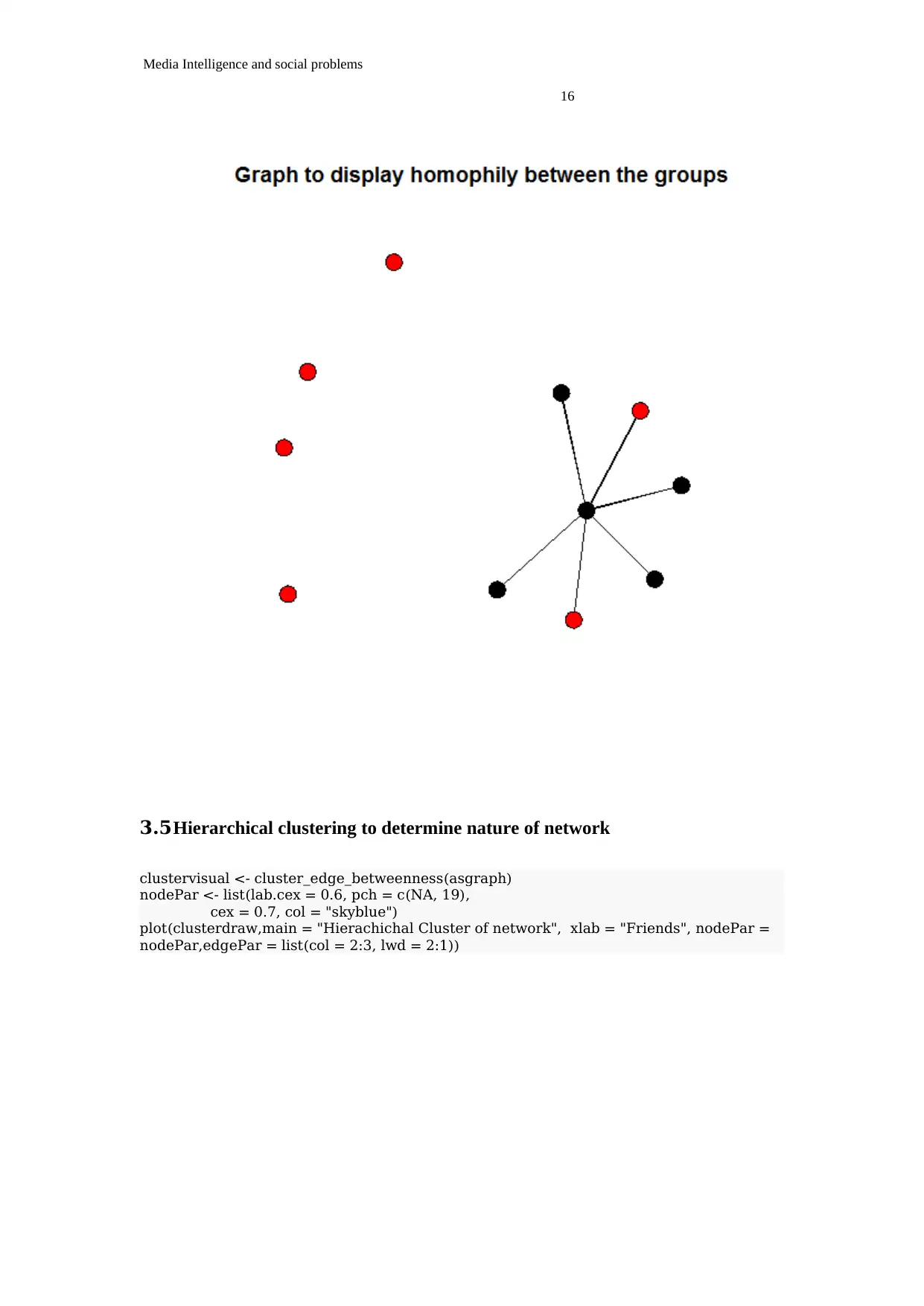
16
Media Intelligence and social problems
3.5Hierarchical clustering to determine nature of network
clustervisual <- cluster_edge_betweenness(asgraph)
nodePar <- list(lab.cex = 0.6, pch = c(NA, 19),
cex = 0.7, col = "skyblue")
plot(clusterdraw,main = "Hierachichal Cluster of network", xlab = "Friends", nodePar =
nodePar,edgePar = list(col = 2:3, lwd = 2:1))
Media Intelligence and social problems
3.5Hierarchical clustering to determine nature of network
clustervisual <- cluster_edge_betweenness(asgraph)
nodePar <- list(lab.cex = 0.6, pch = c(NA, 19),
cex = 0.7, col = "skyblue")
plot(clusterdraw,main = "Hierachichal Cluster of network", xlab = "Friends", nodePar =
nodePar,edgePar = list(col = 2:3, lwd = 2:1))
Secure Best Marks with AI Grader
Need help grading? Try our AI Grader for instant feedback on your assignments.
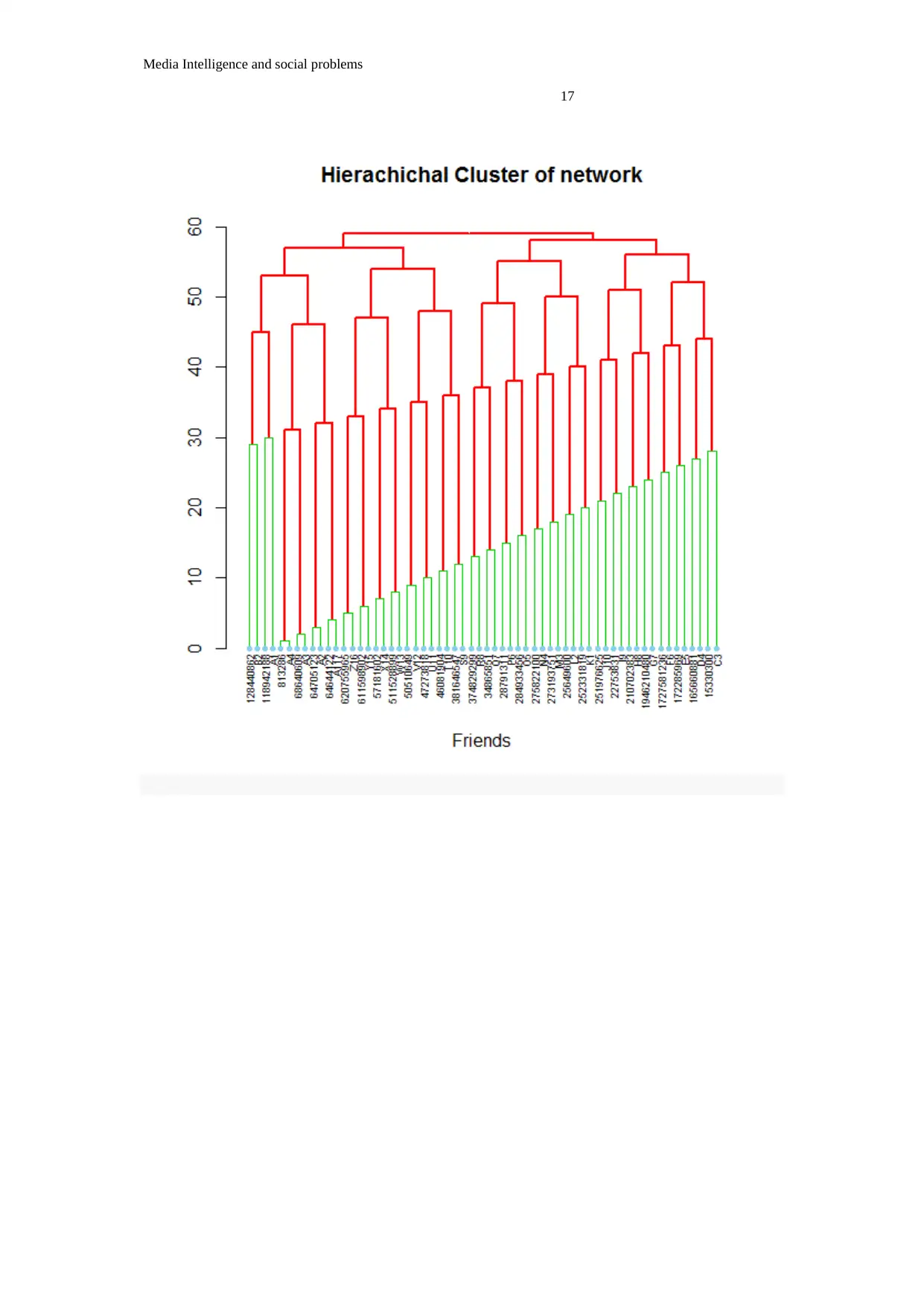
17
Media Intelligence and social problems
Media Intelligence and social problems
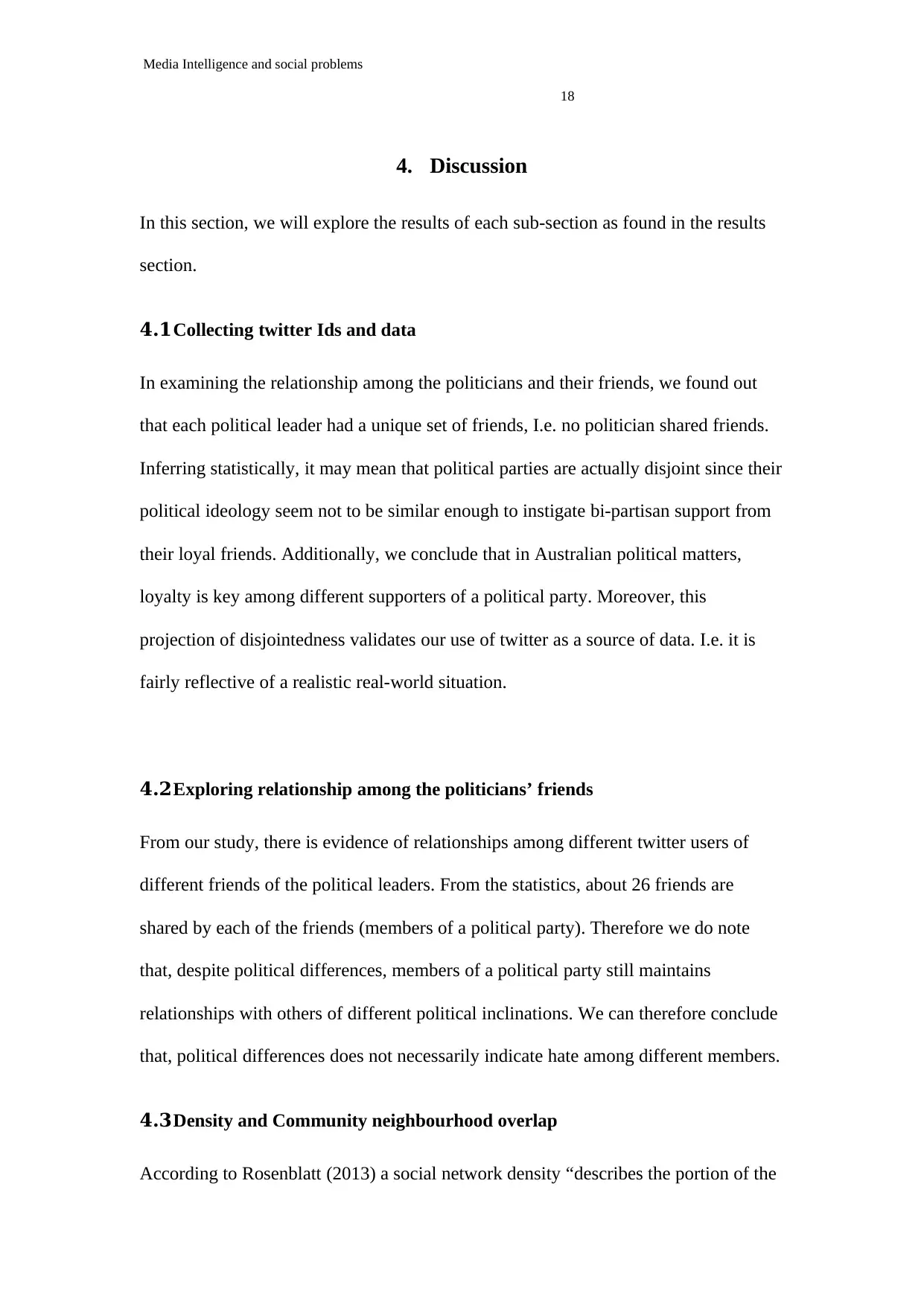
18
Media Intelligence and social problems
4. Discussion
In this section, we will explore the results of each sub-section as found in the results
section.
4.1Collecting twitter Ids and data
In examining the relationship among the politicians and their friends, we found out
that each political leader had a unique set of friends, I.e. no politician shared friends.
Inferring statistically, it may mean that political parties are actually disjoint since their
political ideology seem not to be similar enough to instigate bi-partisan support from
their loyal friends. Additionally, we conclude that in Australian political matters,
loyalty is key among different supporters of a political party. Moreover, this
projection of disjointedness validates our use of twitter as a source of data. I.e. it is
fairly reflective of a realistic real-world situation.
4.2Exploring relationship among the politicians’ friends
From our study, there is evidence of relationships among different twitter users of
different friends of the political leaders. From the statistics, about 26 friends are
shared by each of the friends (members of a political party). Therefore we do note
that, despite political differences, members of a political party still maintains
relationships with others of different political inclinations. We can therefore conclude
that, political differences does not necessarily indicate hate among different members.
4.3Density and Community neighbourhood overlap
According to Rosenblatt (2013) a social network density “describes the portion of the
Media Intelligence and social problems
4. Discussion
In this section, we will explore the results of each sub-section as found in the results
section.
4.1Collecting twitter Ids and data
In examining the relationship among the politicians and their friends, we found out
that each political leader had a unique set of friends, I.e. no politician shared friends.
Inferring statistically, it may mean that political parties are actually disjoint since their
political ideology seem not to be similar enough to instigate bi-partisan support from
their loyal friends. Additionally, we conclude that in Australian political matters,
loyalty is key among different supporters of a political party. Moreover, this
projection of disjointedness validates our use of twitter as a source of data. I.e. it is
fairly reflective of a realistic real-world situation.
4.2Exploring relationship among the politicians’ friends
From our study, there is evidence of relationships among different twitter users of
different friends of the political leaders. From the statistics, about 26 friends are
shared by each of the friends (members of a political party). Therefore we do note
that, despite political differences, members of a political party still maintains
relationships with others of different political inclinations. We can therefore conclude
that, political differences does not necessarily indicate hate among different members.
4.3Density and Community neighbourhood overlap
According to Rosenblatt (2013) a social network density “describes the portion of the
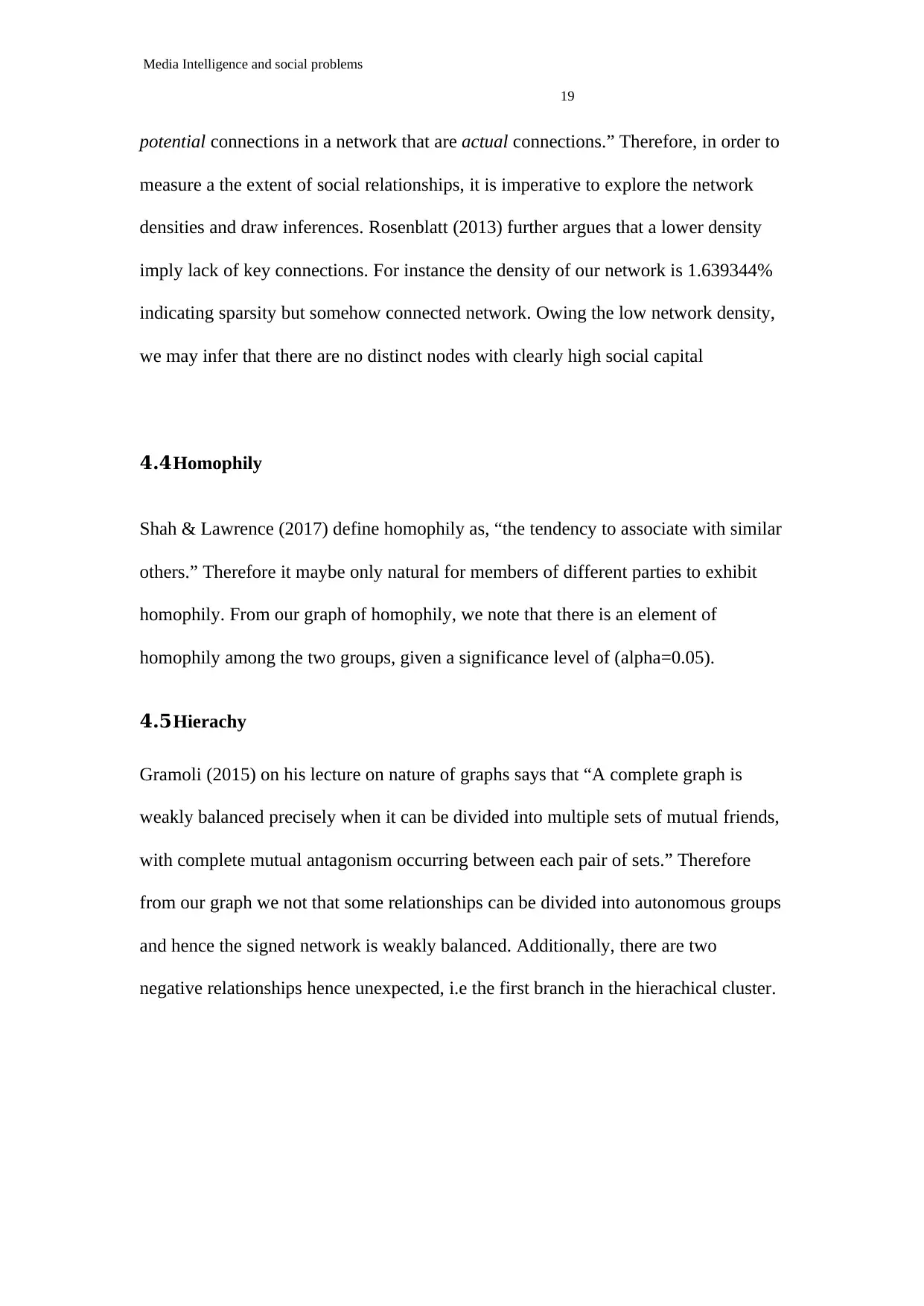
19
Media Intelligence and social problems
potential connections in a network that are actual connections.” Therefore, in order to
measure a the extent of social relationships, it is imperative to explore the network
densities and draw inferences. Rosenblatt (2013) further argues that a lower density
imply lack of key connections. For instance the density of our network is 1.639344%
indicating sparsity but somehow connected network. Owing the low network density,
we may infer that there are no distinct nodes with clearly high social capital
4.4Homophily
Shah & Lawrence (2017) define homophily as, “the tendency to associate with similar
others.” Therefore it maybe only natural for members of different parties to exhibit
homophily. From our graph of homophily, we note that there is an element of
homophily among the two groups, given a significance level of (alpha=0.05).
4.5Hierachy
Gramoli (2015) on his lecture on nature of graphs says that “A complete graph is
weakly balanced precisely when it can be divided into multiple sets of mutual friends,
with complete mutual antagonism occurring between each pair of sets.” Therefore
from our graph we not that some relationships can be divided into autonomous groups
and hence the signed network is weakly balanced. Additionally, there are two
negative relationships hence unexpected, i.e the first branch in the hierachical cluster.
Media Intelligence and social problems
potential connections in a network that are actual connections.” Therefore, in order to
measure a the extent of social relationships, it is imperative to explore the network
densities and draw inferences. Rosenblatt (2013) further argues that a lower density
imply lack of key connections. For instance the density of our network is 1.639344%
indicating sparsity but somehow connected network. Owing the low network density,
we may infer that there are no distinct nodes with clearly high social capital
4.4Homophily
Shah & Lawrence (2017) define homophily as, “the tendency to associate with similar
others.” Therefore it maybe only natural for members of different parties to exhibit
homophily. From our graph of homophily, we note that there is an element of
homophily among the two groups, given a significance level of (alpha=0.05).
4.5Hierachy
Gramoli (2015) on his lecture on nature of graphs says that “A complete graph is
weakly balanced precisely when it can be divided into multiple sets of mutual friends,
with complete mutual antagonism occurring between each pair of sets.” Therefore
from our graph we not that some relationships can be divided into autonomous groups
and hence the signed network is weakly balanced. Additionally, there are two
negative relationships hence unexpected, i.e the first branch in the hierachical cluster.
Paraphrase This Document
Need a fresh take? Get an instant paraphrase of this document with our AI Paraphraser
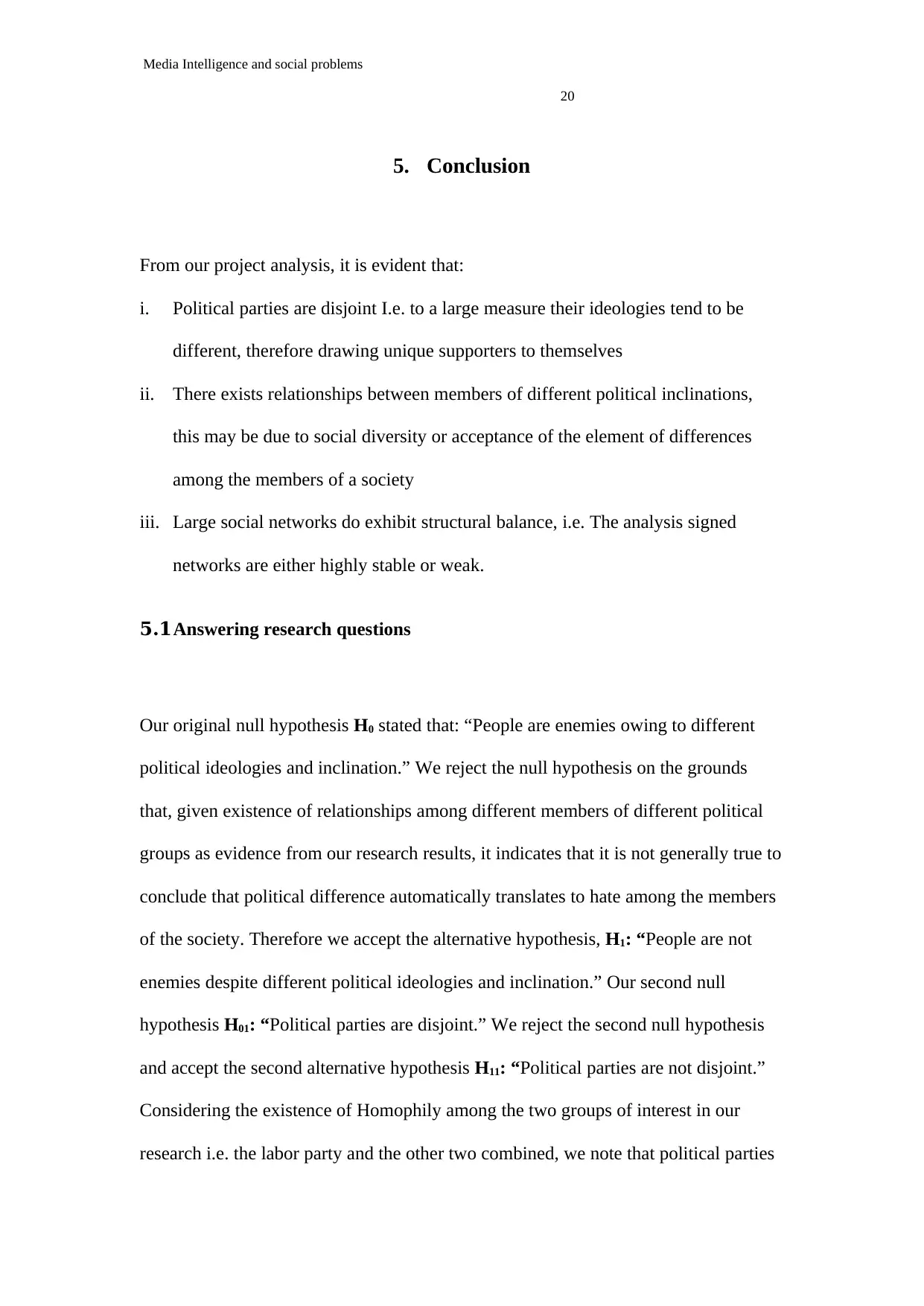
20
Media Intelligence and social problems
5. Conclusion
From our project analysis, it is evident that:
i. Political parties are disjoint I.e. to a large measure their ideologies tend to be
different, therefore drawing unique supporters to themselves
ii. There exists relationships between members of different political inclinations,
this may be due to social diversity or acceptance of the element of differences
among the members of a society
iii. Large social networks do exhibit structural balance, i.e. The analysis signed
networks are either highly stable or weak.
5.1Answering research questions
Our original null hypothesis H0 stated that: “People are enemies owing to different
political ideologies and inclination.” We reject the null hypothesis on the grounds
that, given existence of relationships among different members of different political
groups as evidence from our research results, it indicates that it is not generally true to
conclude that political difference automatically translates to hate among the members
of the society. Therefore we accept the alternative hypothesis, H1: “People are not
enemies despite different political ideologies and inclination.” Our second null
hypothesis H01: “Political parties are disjoint.” We reject the second null hypothesis
and accept the second alternative hypothesis H11: “Political parties are not disjoint.”
Considering the existence of Homophily among the two groups of interest in our
research i.e. the labor party and the other two combined, we note that political parties
Media Intelligence and social problems
5. Conclusion
From our project analysis, it is evident that:
i. Political parties are disjoint I.e. to a large measure their ideologies tend to be
different, therefore drawing unique supporters to themselves
ii. There exists relationships between members of different political inclinations,
this may be due to social diversity or acceptance of the element of differences
among the members of a society
iii. Large social networks do exhibit structural balance, i.e. The analysis signed
networks are either highly stable or weak.
5.1Answering research questions
Our original null hypothesis H0 stated that: “People are enemies owing to different
political ideologies and inclination.” We reject the null hypothesis on the grounds
that, given existence of relationships among different members of different political
groups as evidence from our research results, it indicates that it is not generally true to
conclude that political difference automatically translates to hate among the members
of the society. Therefore we accept the alternative hypothesis, H1: “People are not
enemies despite different political ideologies and inclination.” Our second null
hypothesis H01: “Political parties are disjoint.” We reject the second null hypothesis
and accept the second alternative hypothesis H11: “Political parties are not disjoint.”
Considering the existence of Homophily among the two groups of interest in our
research i.e. the labor party and the other two combined, we note that political parties
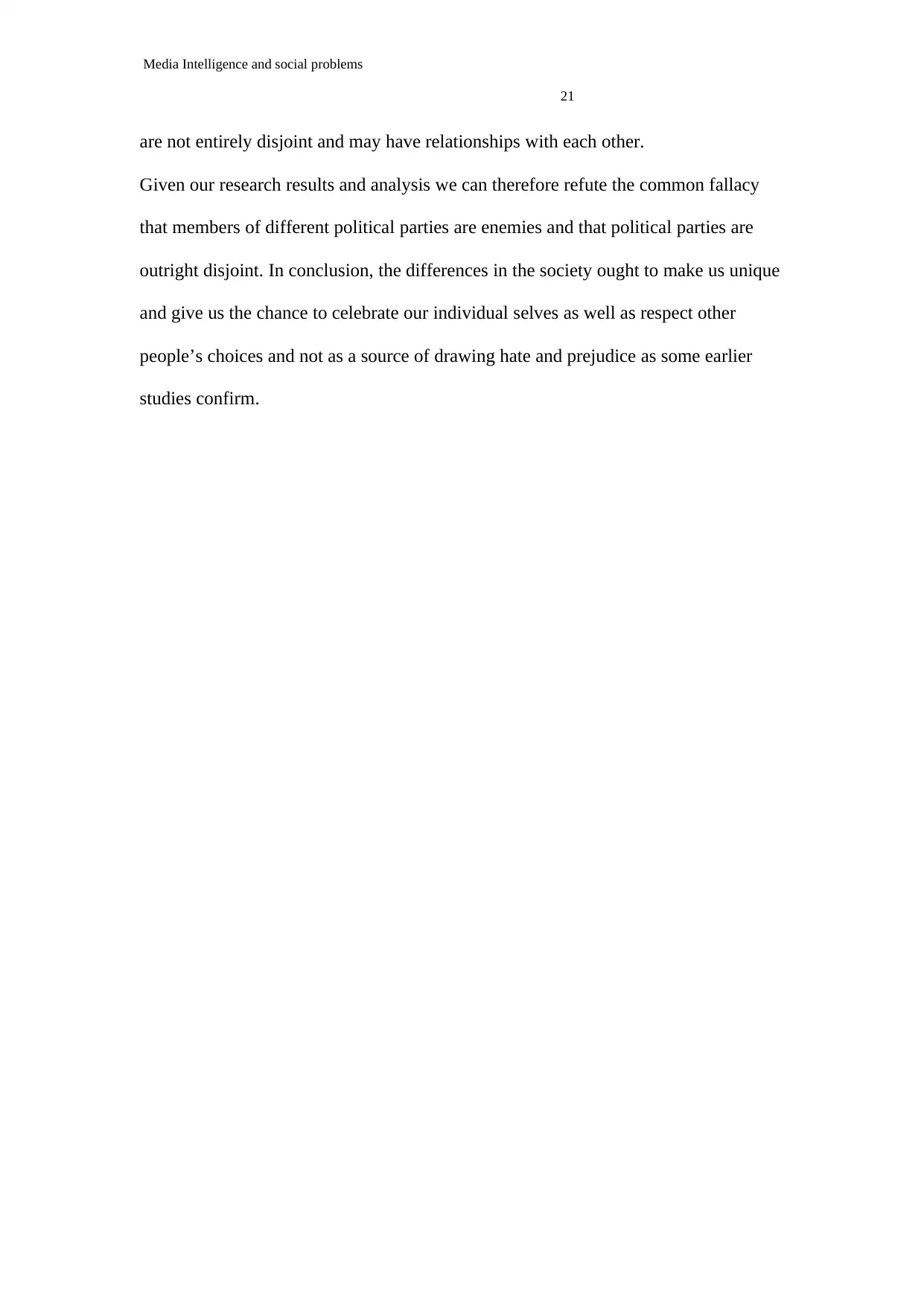
21
Media Intelligence and social problems
are not entirely disjoint and may have relationships with each other.
Given our research results and analysis we can therefore refute the common fallacy
that members of different political parties are enemies and that political parties are
outright disjoint. In conclusion, the differences in the society ought to make us unique
and give us the chance to celebrate our individual selves as well as respect other
people’s choices and not as a source of drawing hate and prejudice as some earlier
studies confirm.
Media Intelligence and social problems
are not entirely disjoint and may have relationships with each other.
Given our research results and analysis we can therefore refute the common fallacy
that members of different political parties are enemies and that political parties are
outright disjoint. In conclusion, the differences in the society ought to make us unique
and give us the chance to celebrate our individual selves as well as respect other
people’s choices and not as a source of drawing hate and prejudice as some earlier
studies confirm.
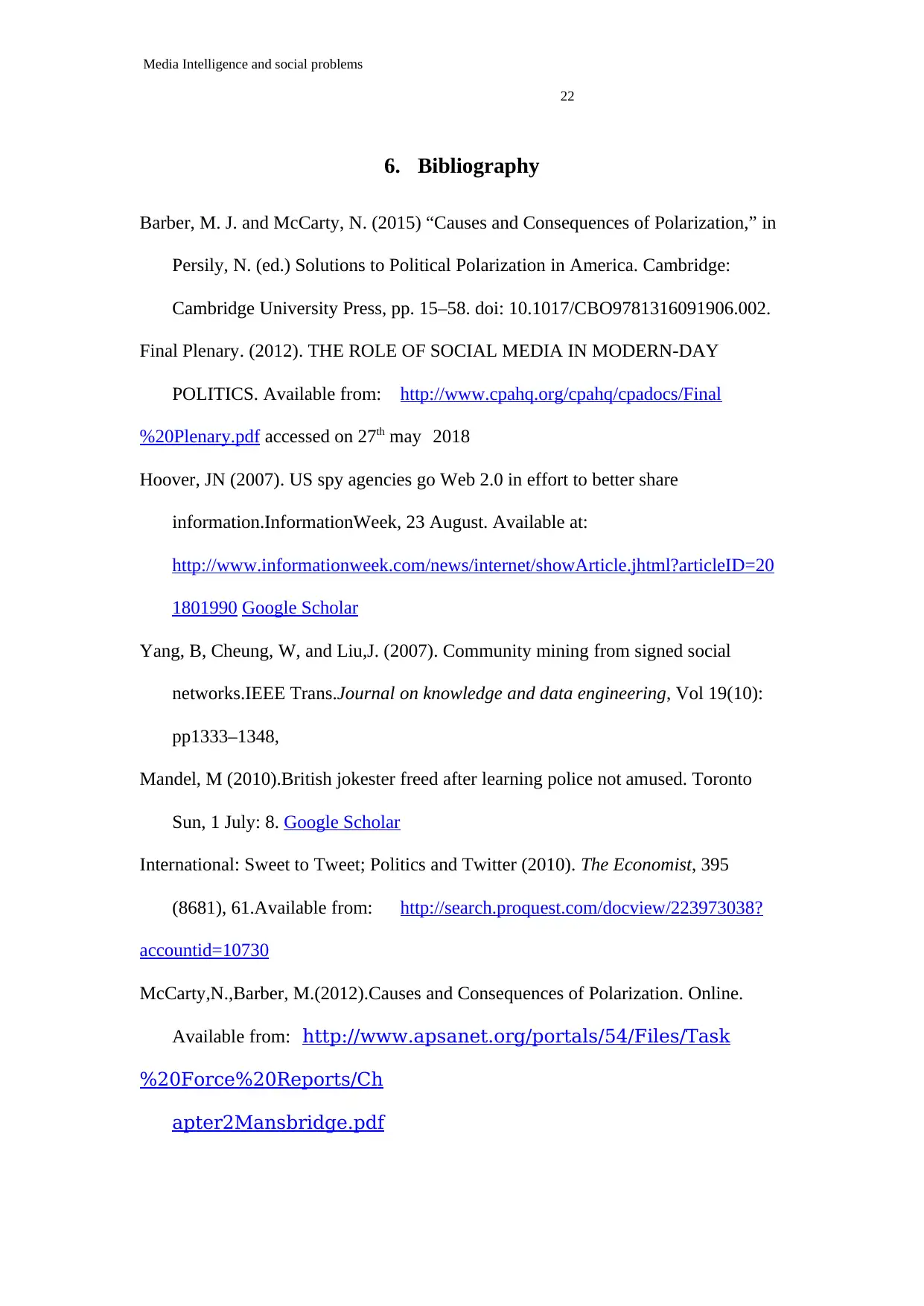
22
Media Intelligence and social problems
6. Bibliography
Barber, M. J. and McCarty, N. (2015) “Causes and Consequences of Polarization,” in
Persily, N. (ed.) Solutions to Political Polarization in America. Cambridge:
Cambridge University Press, pp. 15–58. doi: 10.1017/CBO9781316091906.002.
Final Plenary. (2012). THE ROLE OF SOCIAL MEDIA IN MODERN-DAY
POLITICS. Available from: http://www.cpahq.org/cpahq/cpadocs/Final
%20Plenary.pdf accessed on 27th may 2018
Hoover, JN (2007). US spy agencies go Web 2.0 in effort to better share
information.InformationWeek, 23 August. Available at:
http://www.informationweek.com/news/internet/showArticle.jhtml?articleID=20
1801990 Google Scholar
Yang, B, Cheung, W, and Liu,J. (2007). Community mining from signed social
networks.IEEE Trans.Journal on knowledge and data engineering, Vol 19(10):
pp1333–1348,
Mandel, M (2010).British jokester freed after learning police not amused. Toronto
Sun, 1 July: 8. Google Scholar
International: Sweet to Tweet; Politics and Twitter (2010). The Economist, 395
(8681), 61.Available from: http://search.proquest.com/docview/223973038?
accountid=10730
McCarty,N.,Barber, M.(2012).Causes and Consequences of Polarization. Online.
Available from: http://www.apsanet.org/portals/54/Files/Task
%20Force%20Reports/Ch
apter2Mansbridge.pdf
Media Intelligence and social problems
6. Bibliography
Barber, M. J. and McCarty, N. (2015) “Causes and Consequences of Polarization,” in
Persily, N. (ed.) Solutions to Political Polarization in America. Cambridge:
Cambridge University Press, pp. 15–58. doi: 10.1017/CBO9781316091906.002.
Final Plenary. (2012). THE ROLE OF SOCIAL MEDIA IN MODERN-DAY
POLITICS. Available from: http://www.cpahq.org/cpahq/cpadocs/Final
%20Plenary.pdf accessed on 27th may 2018
Hoover, JN (2007). US spy agencies go Web 2.0 in effort to better share
information.InformationWeek, 23 August. Available at:
http://www.informationweek.com/news/internet/showArticle.jhtml?articleID=20
1801990 Google Scholar
Yang, B, Cheung, W, and Liu,J. (2007). Community mining from signed social
networks.IEEE Trans.Journal on knowledge and data engineering, Vol 19(10):
pp1333–1348,
Mandel, M (2010).British jokester freed after learning police not amused. Toronto
Sun, 1 July: 8. Google Scholar
International: Sweet to Tweet; Politics and Twitter (2010). The Economist, 395
(8681), 61.Available from: http://search.proquest.com/docview/223973038?
accountid=10730
McCarty,N.,Barber, M.(2012).Causes and Consequences of Polarization. Online.
Available from: http://www.apsanet.org/portals/54/Files/Task
%20Force%20Reports/Ch
apter2Mansbridge.pdf
Secure Best Marks with AI Grader
Need help grading? Try our AI Grader for instant feedback on your assignments.
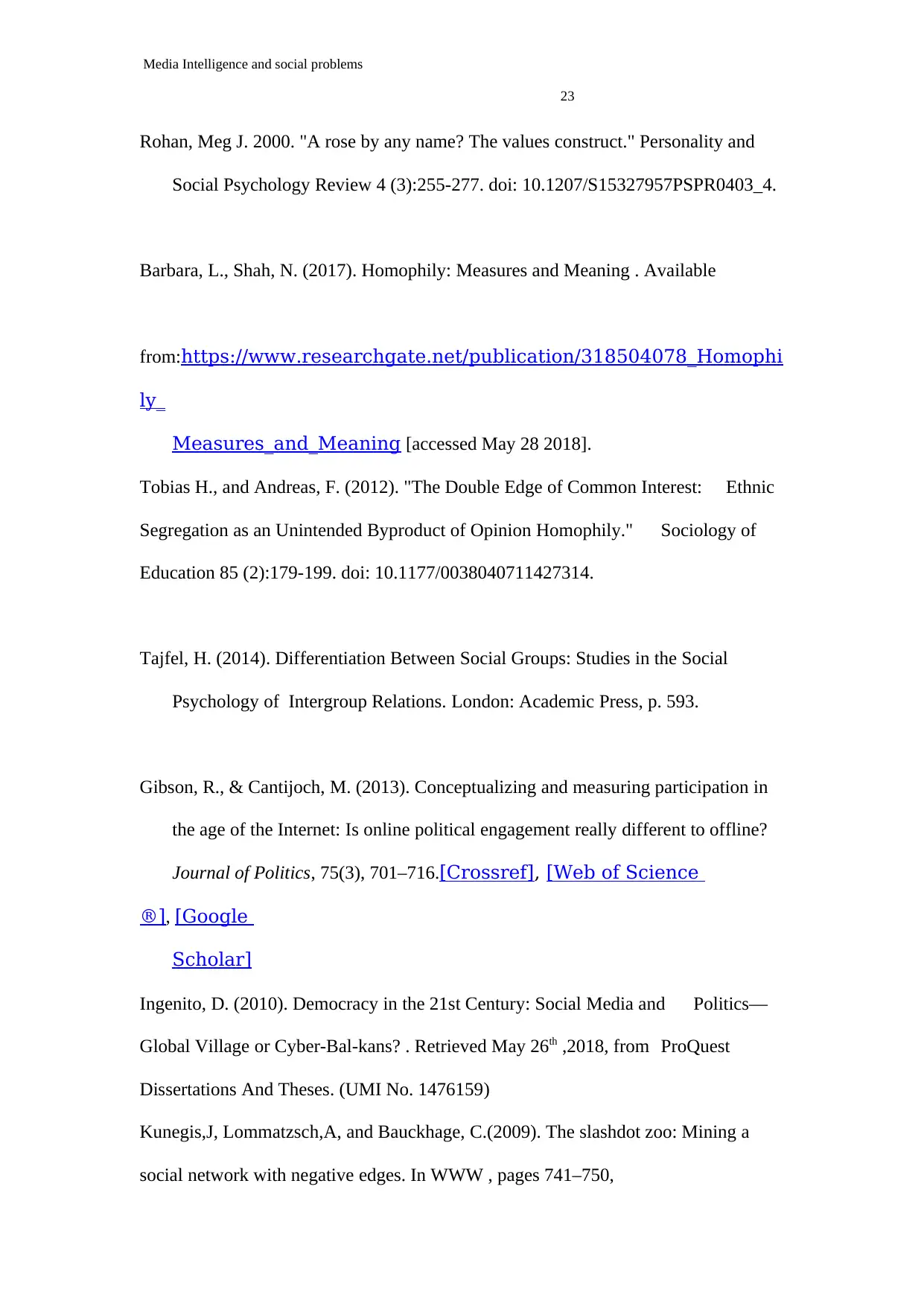
23
Media Intelligence and social problems
Rohan, Meg J. 2000. "A rose by any name? The values construct." Personality and
Social Psychology Review 4 (3):255-277. doi: 10.1207/S15327957PSPR0403_4.
Barbara, L., Shah, N. (2017). Homophily: Measures and Meaning . Available
from:https://www.researchgate.net/publication/318504078_Homophi
ly_
Measures_and_Meaning [accessed May 28 2018].
Tobias H., and Andreas, F. (2012). "The Double Edge of Common Interest: Ethnic
Segregation as an Unintended Byproduct of Opinion Homophily." Sociology of
Education 85 (2):179-199. doi: 10.1177/0038040711427314.
Tajfel, H. (2014). Differentiation Between Social Groups: Studies in the Social
Psychology of Intergroup Relations. London: Academic Press, p. 593.
Gibson, R., & Cantijoch, M. (2013). Conceptualizing and measuring participation in
the age of the Internet: Is online political engagement really different to offline?
Journal of Politics, 75(3), 701–716.[Crossref], [Web of Science
®], [Google
Scholar]
Ingenito, D. (2010). Democracy in the 21st Century: Social Media and Politics—
Global Village or Cyber-Bal-kans? . Retrieved May 26th ,2018, from ProQuest
Dissertations And Theses. (UMI No. 1476159)
Kunegis,J, Lommatzsch,A, and Bauckhage, C.(2009). The slashdot zoo: Mining a
social network with negative edges. In WWW , pages 741–750,
Media Intelligence and social problems
Rohan, Meg J. 2000. "A rose by any name? The values construct." Personality and
Social Psychology Review 4 (3):255-277. doi: 10.1207/S15327957PSPR0403_4.
Barbara, L., Shah, N. (2017). Homophily: Measures and Meaning . Available
from:https://www.researchgate.net/publication/318504078_Homophi
ly_
Measures_and_Meaning [accessed May 28 2018].
Tobias H., and Andreas, F. (2012). "The Double Edge of Common Interest: Ethnic
Segregation as an Unintended Byproduct of Opinion Homophily." Sociology of
Education 85 (2):179-199. doi: 10.1177/0038040711427314.
Tajfel, H. (2014). Differentiation Between Social Groups: Studies in the Social
Psychology of Intergroup Relations. London: Academic Press, p. 593.
Gibson, R., & Cantijoch, M. (2013). Conceptualizing and measuring participation in
the age of the Internet: Is online political engagement really different to offline?
Journal of Politics, 75(3), 701–716.[Crossref], [Web of Science
Scholar]
Ingenito, D. (2010). Democracy in the 21st Century: Social Media and Politics—
Global Village or Cyber-Bal-kans? . Retrieved May 26th ,2018, from ProQuest
Dissertations And Theses. (UMI No. 1476159)
Kunegis,J, Lommatzsch,A, and Bauckhage, C.(2009). The slashdot zoo: Mining a
social network with negative edges. In WWW , pages 741–750,

24
Media Intelligence and social problems
Media Intelligence and social problems

25
Media Intelligence and social problems
Media Intelligence and social problems
1 out of 25
Related Documents
Your All-in-One AI-Powered Toolkit for Academic Success.
+13062052269
info@desklib.com
Available 24*7 on WhatsApp / Email
![[object Object]](/_next/static/media/star-bottom.7253800d.svg)
Unlock your academic potential
© 2024 | Zucol Services PVT LTD | All rights reserved.





